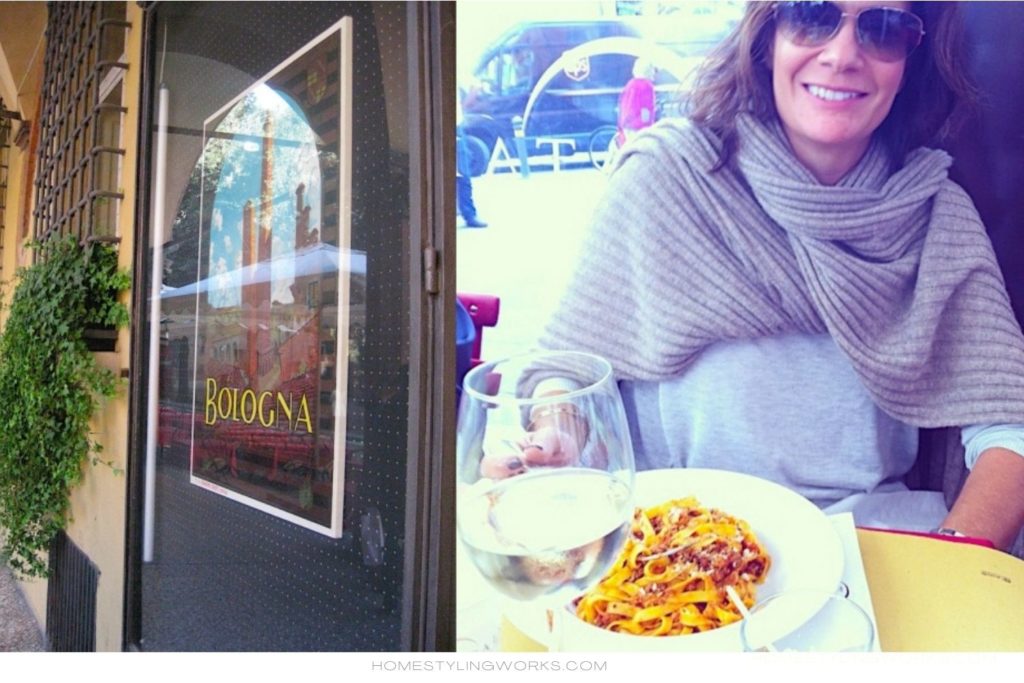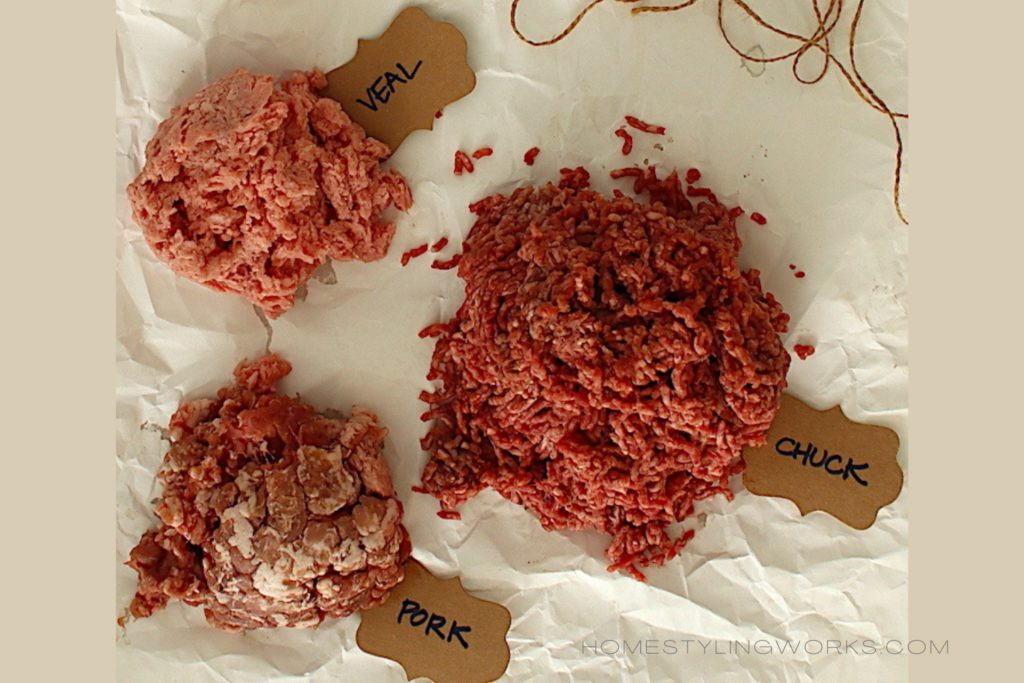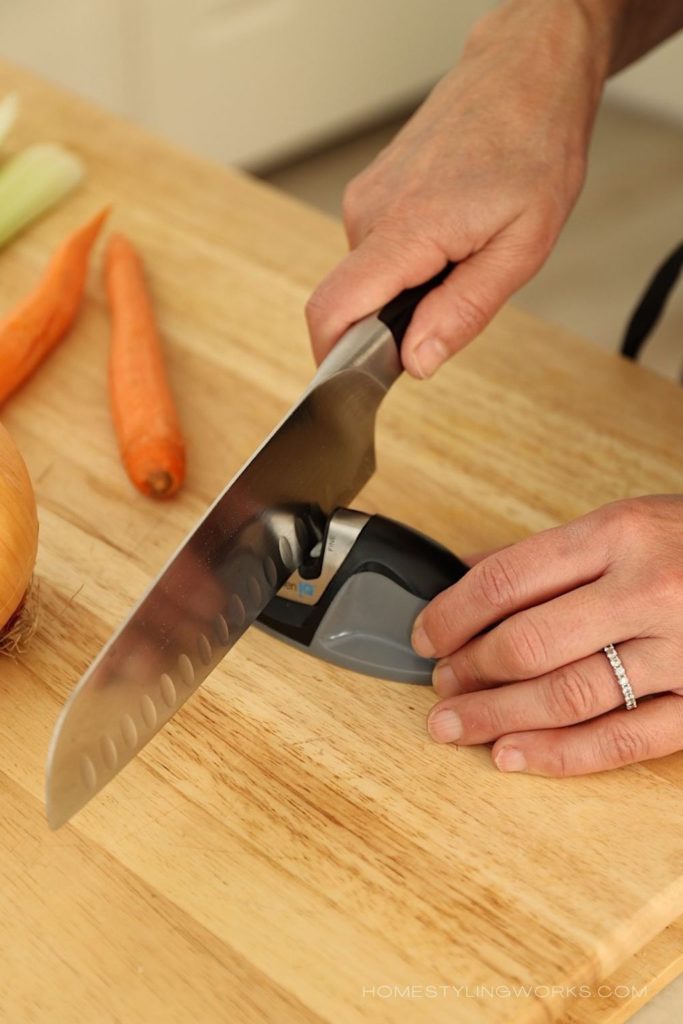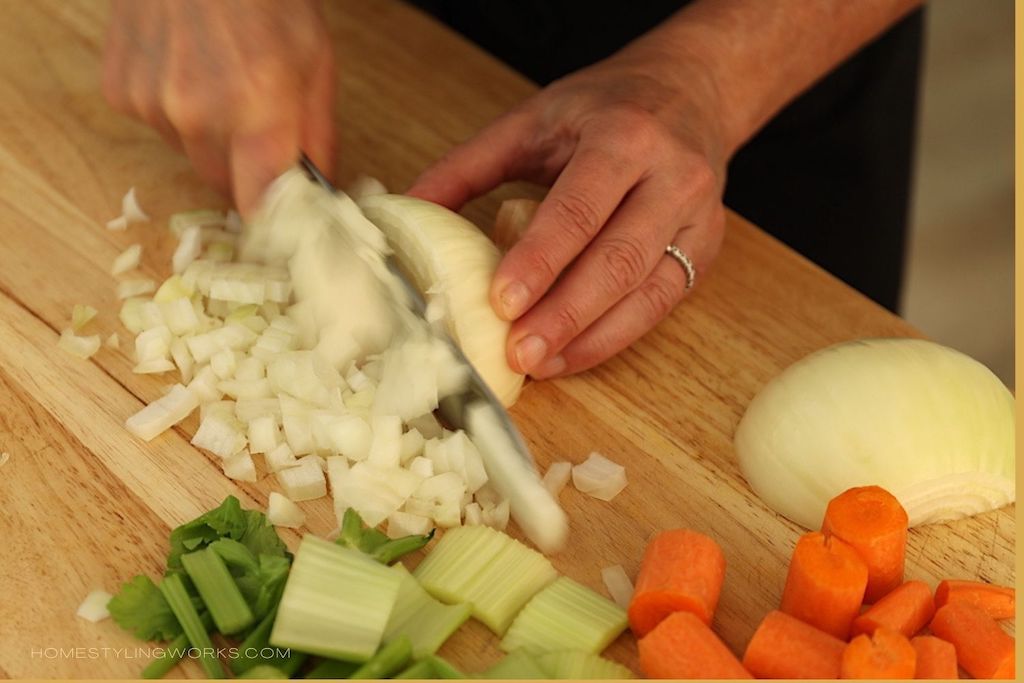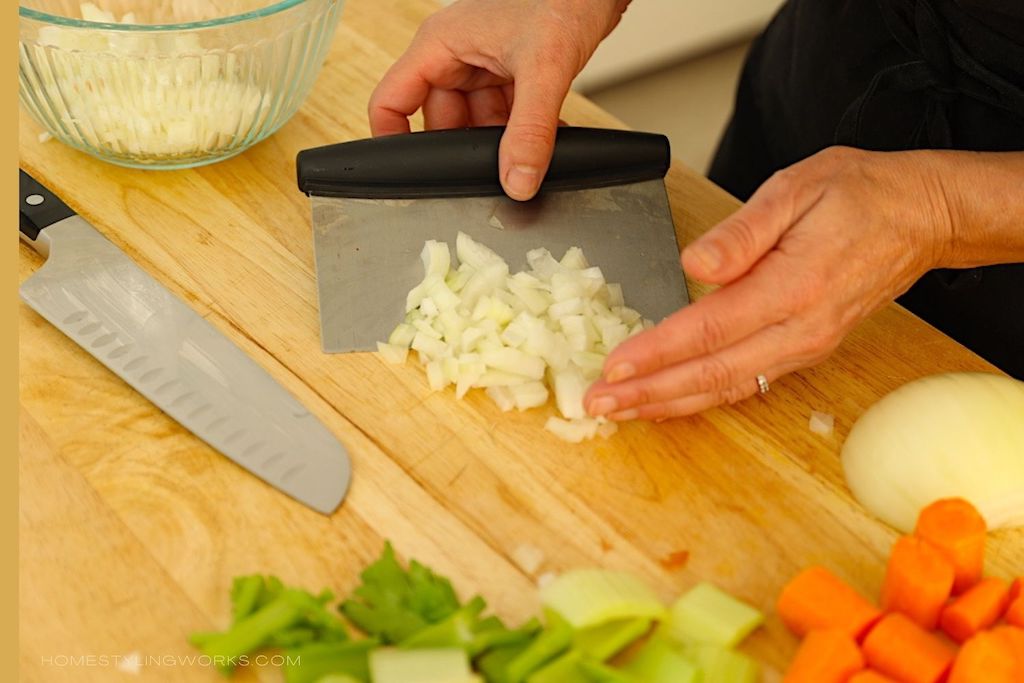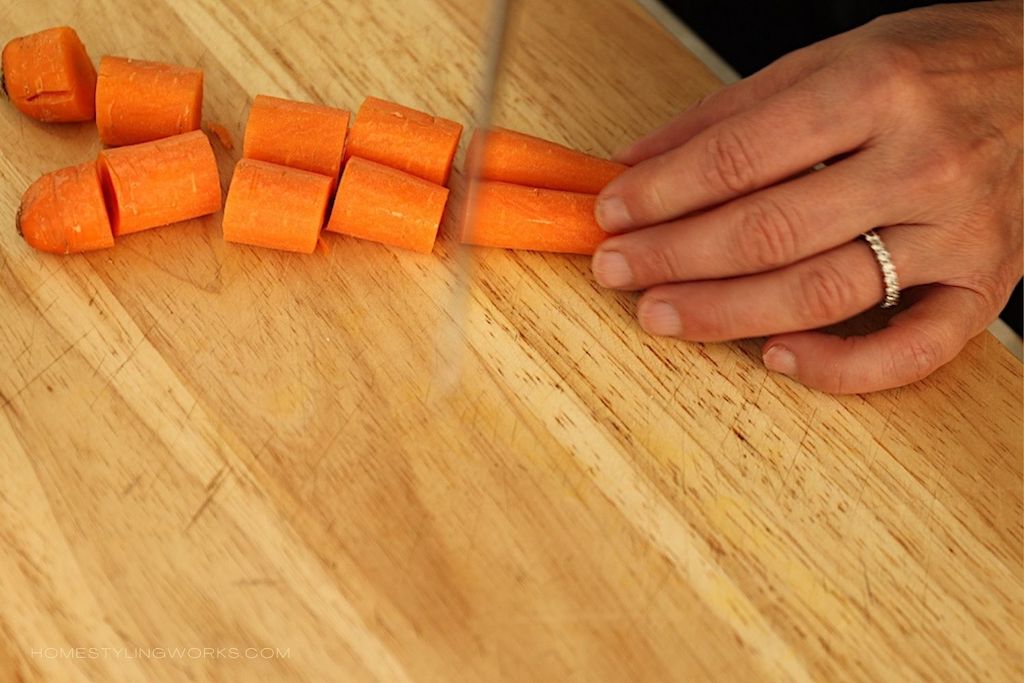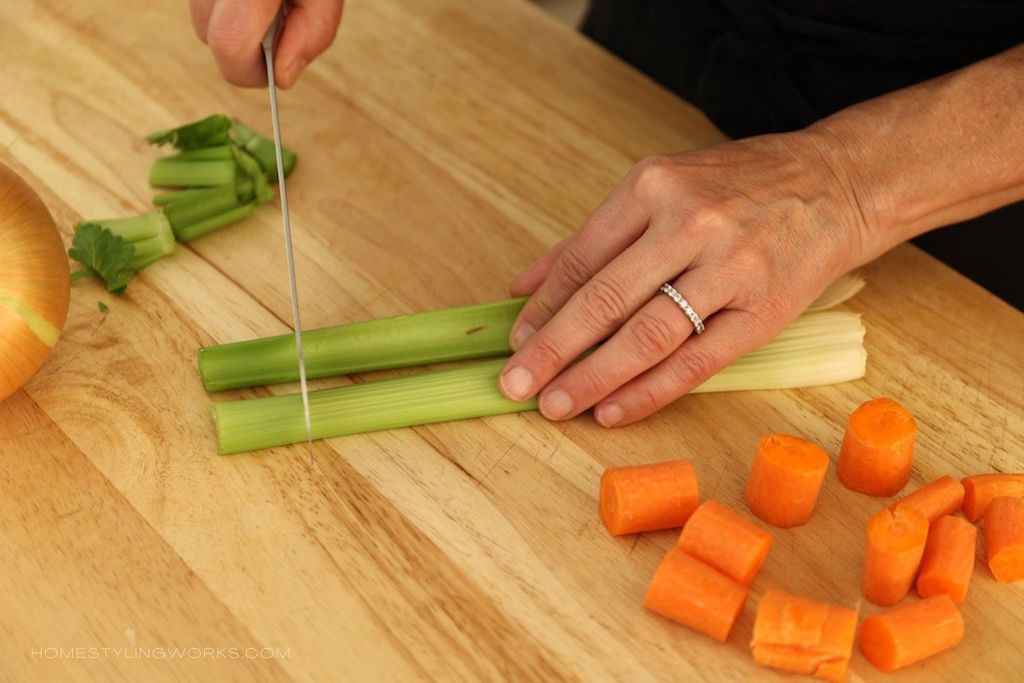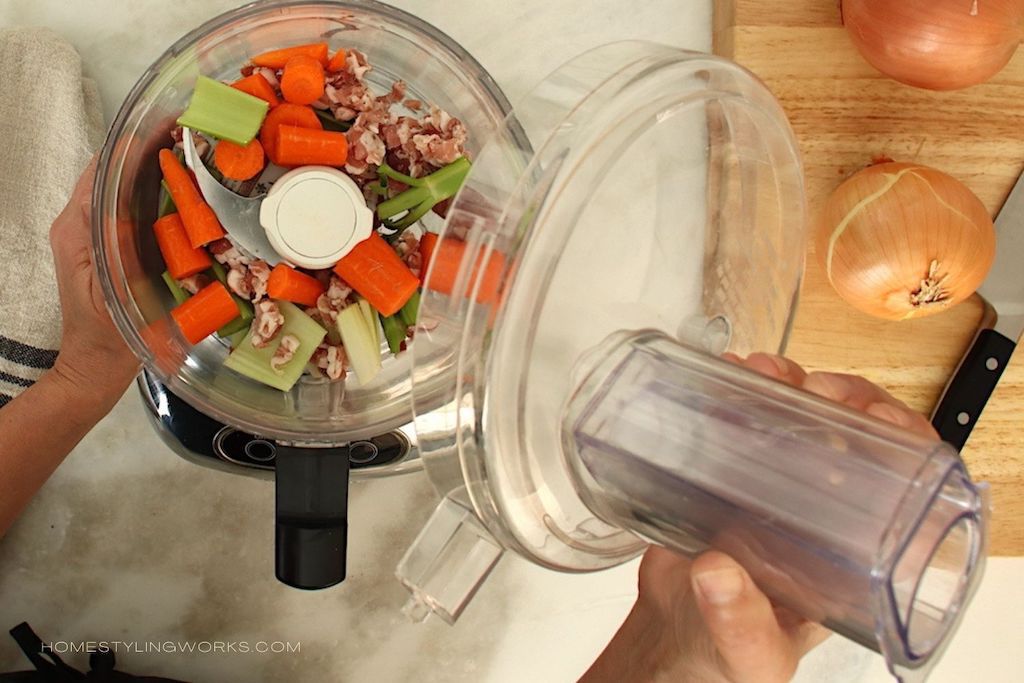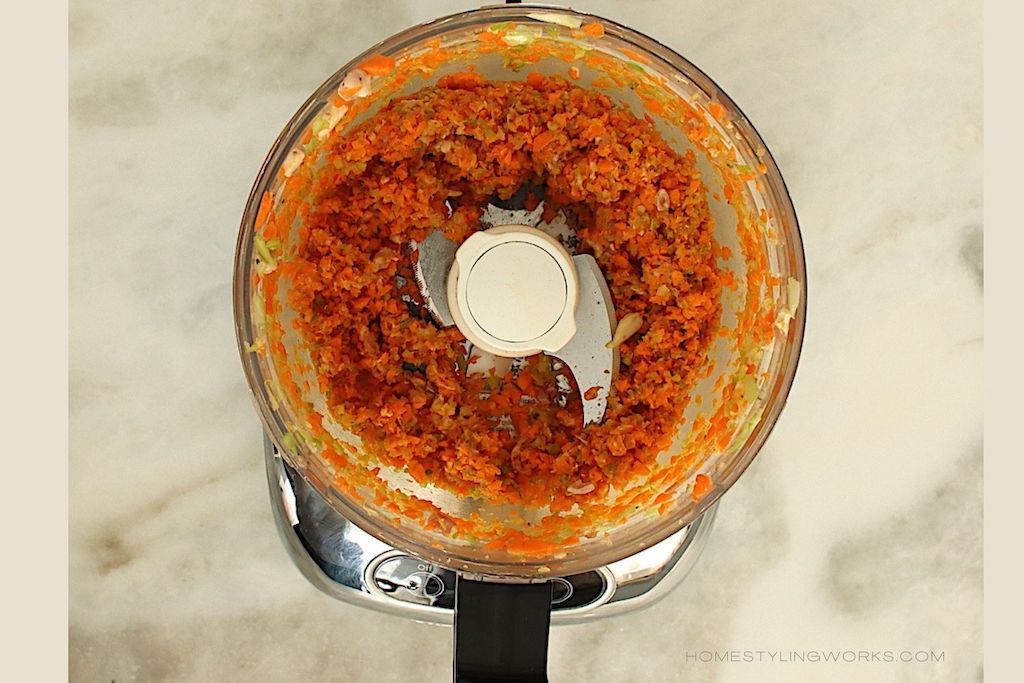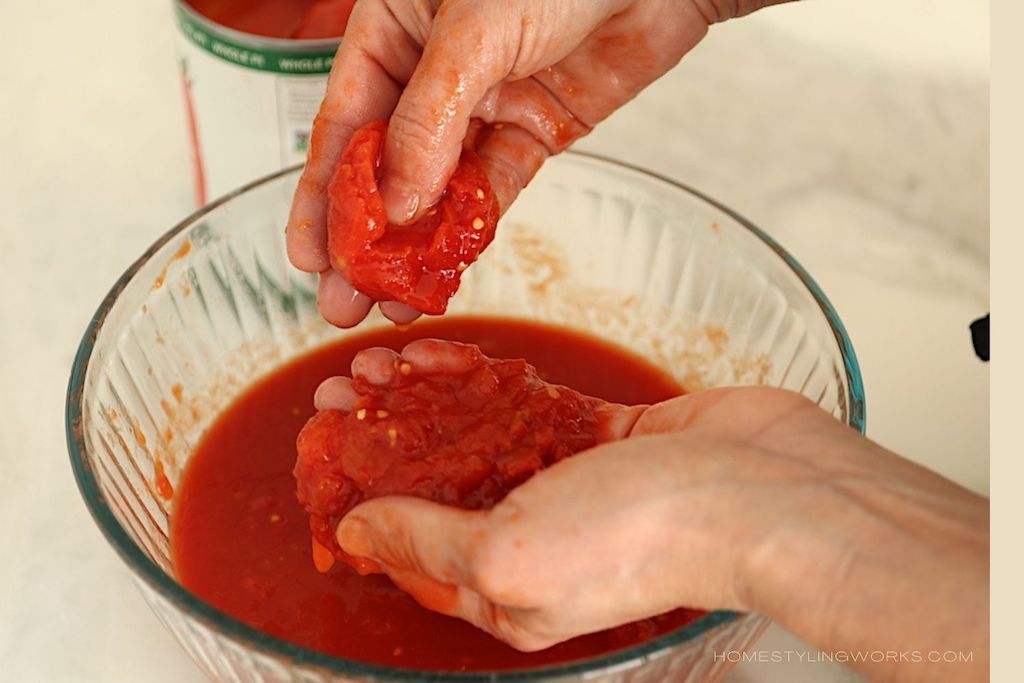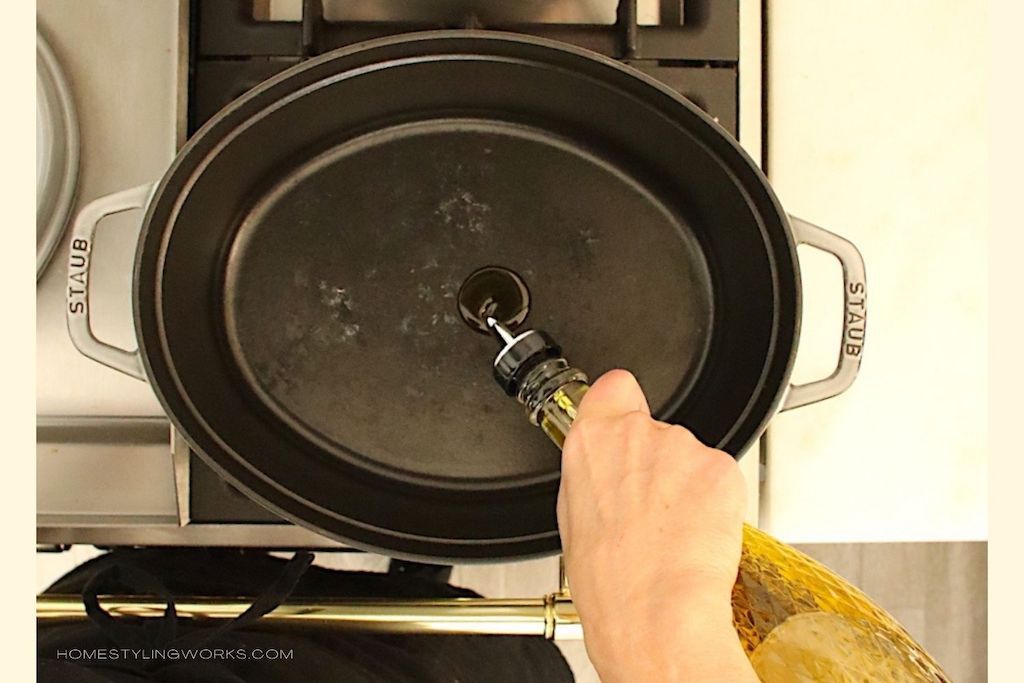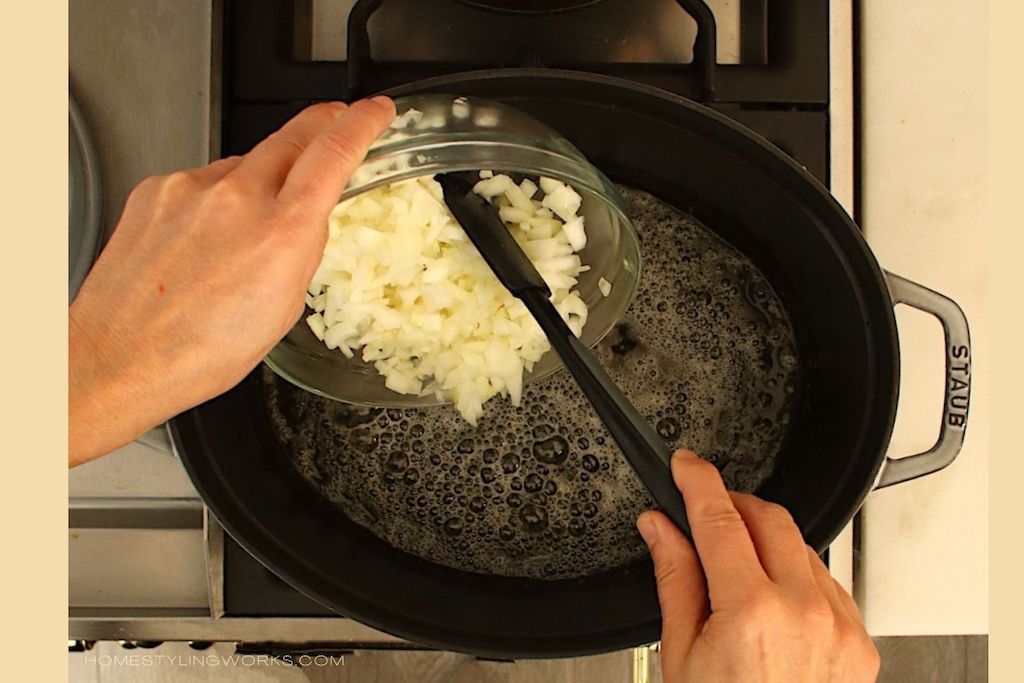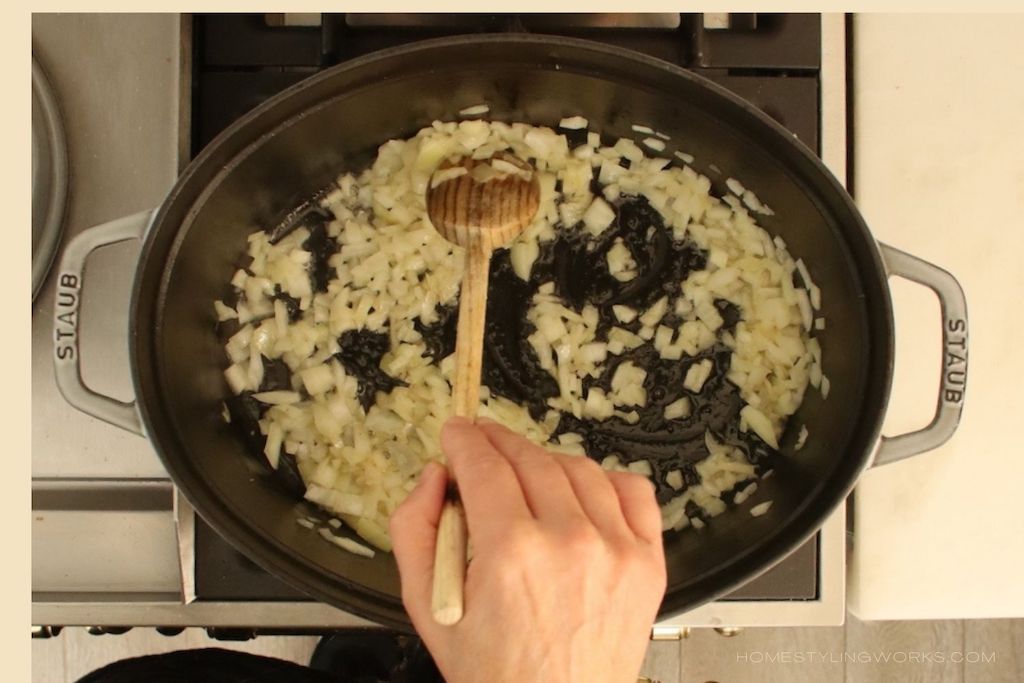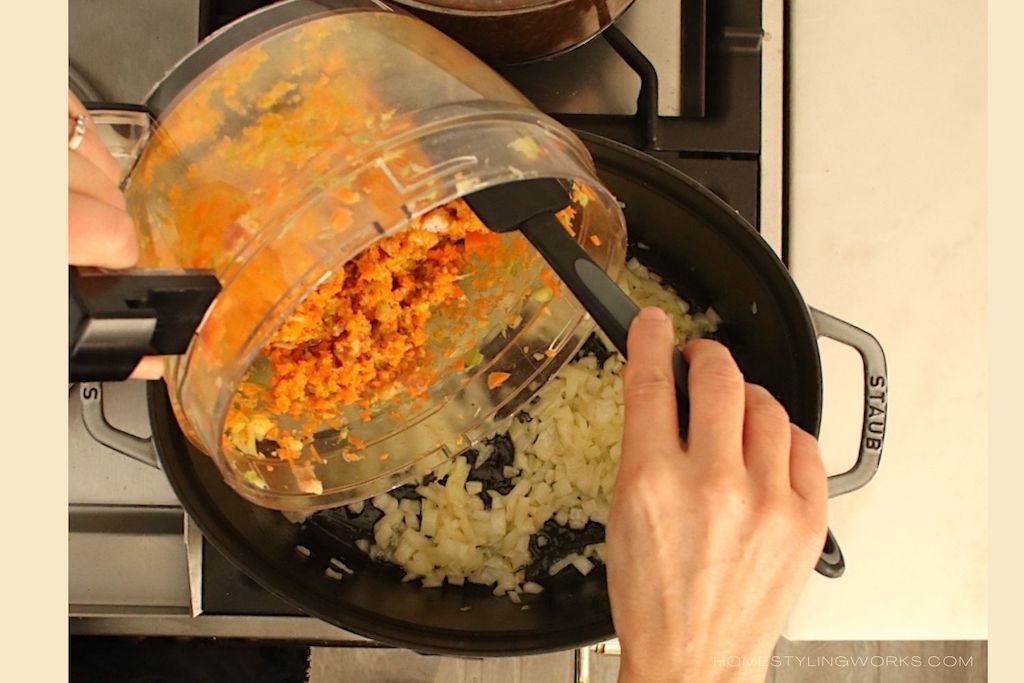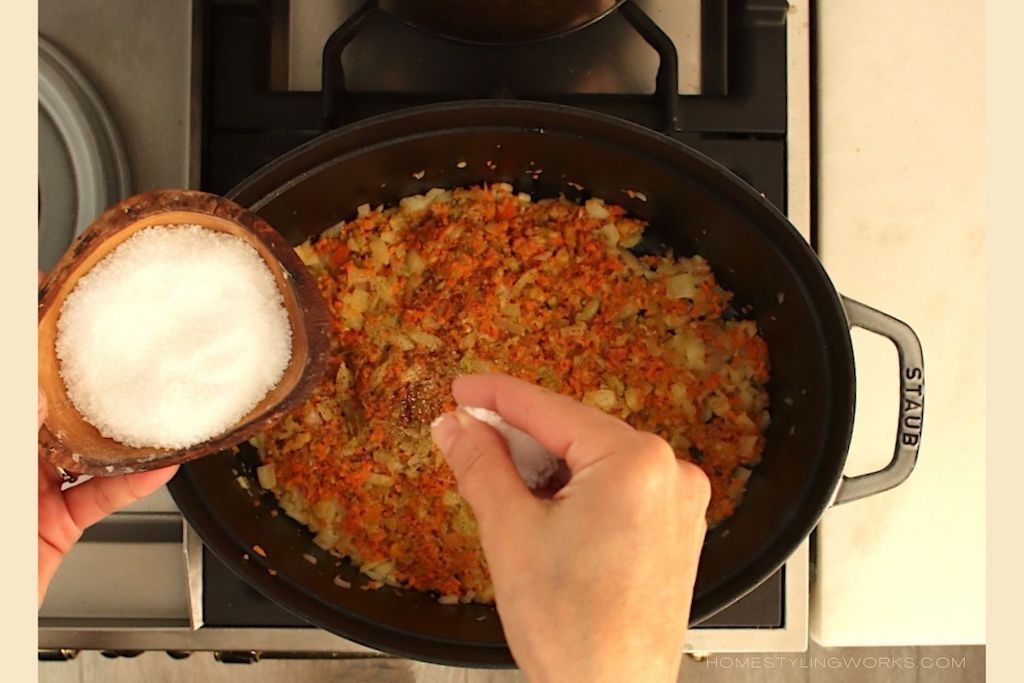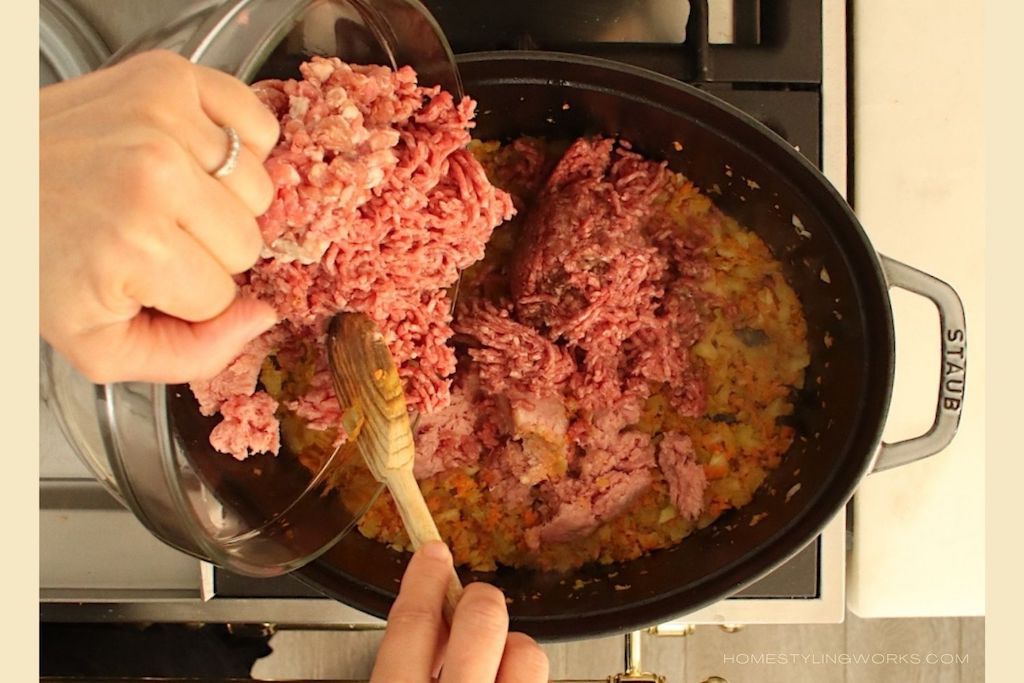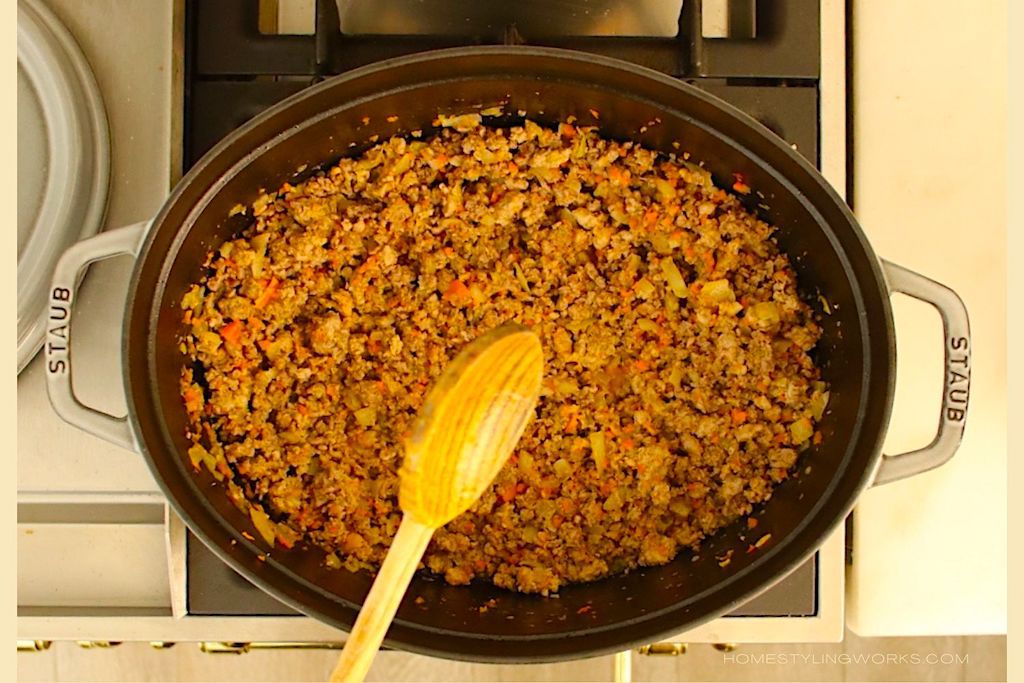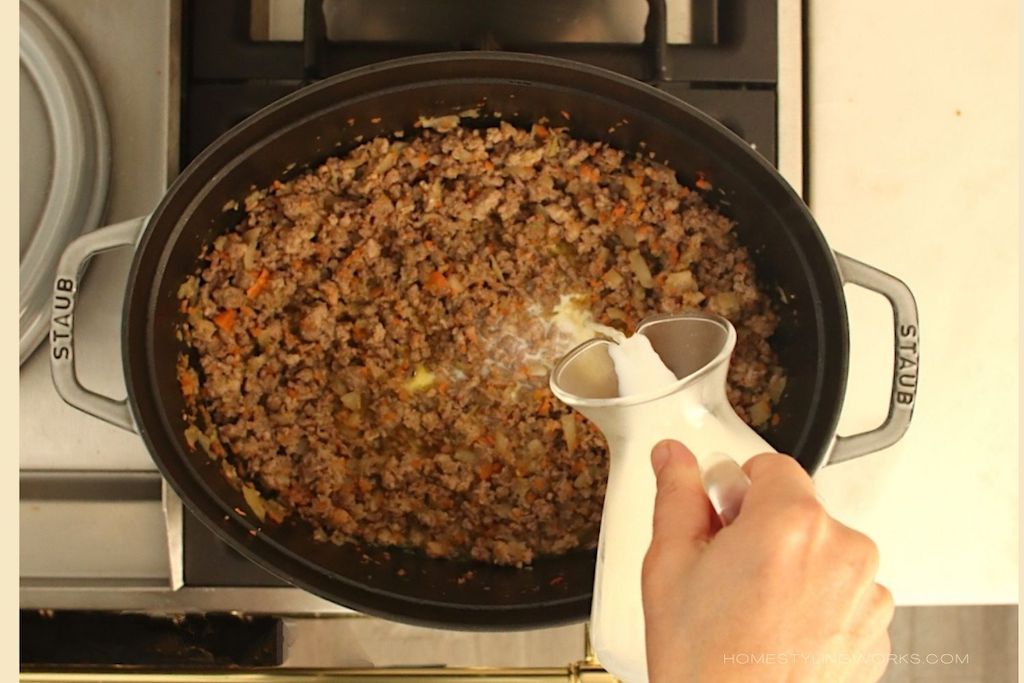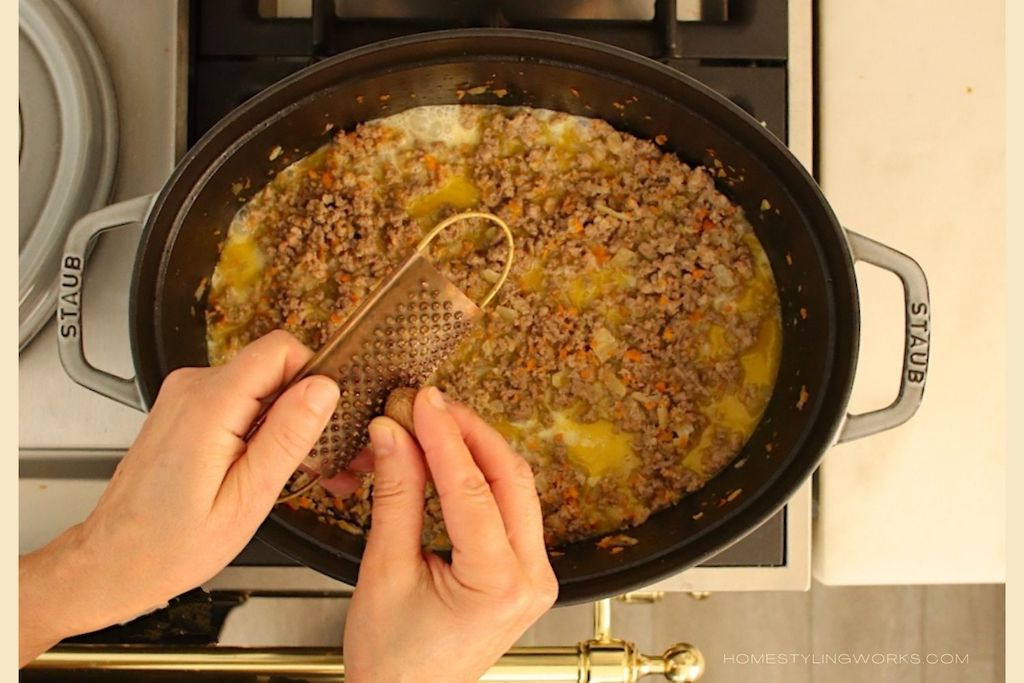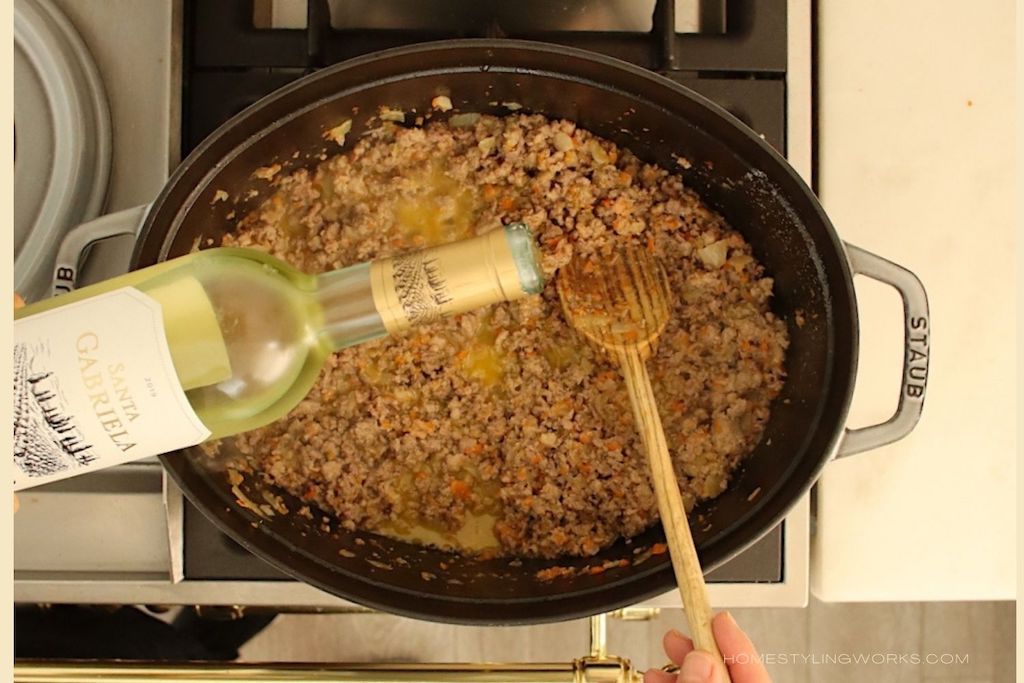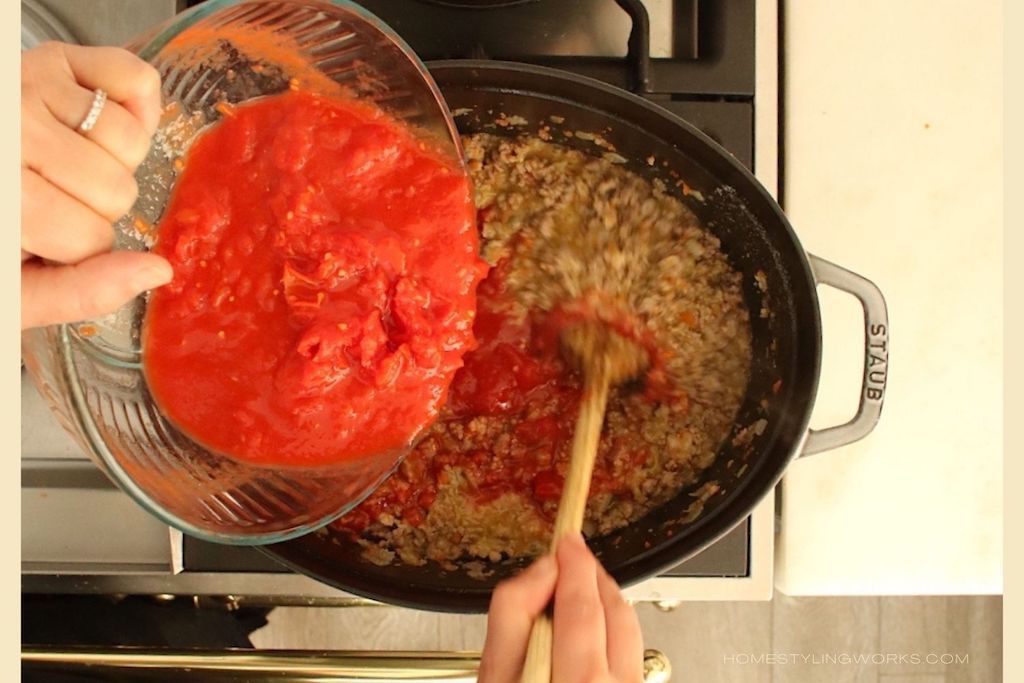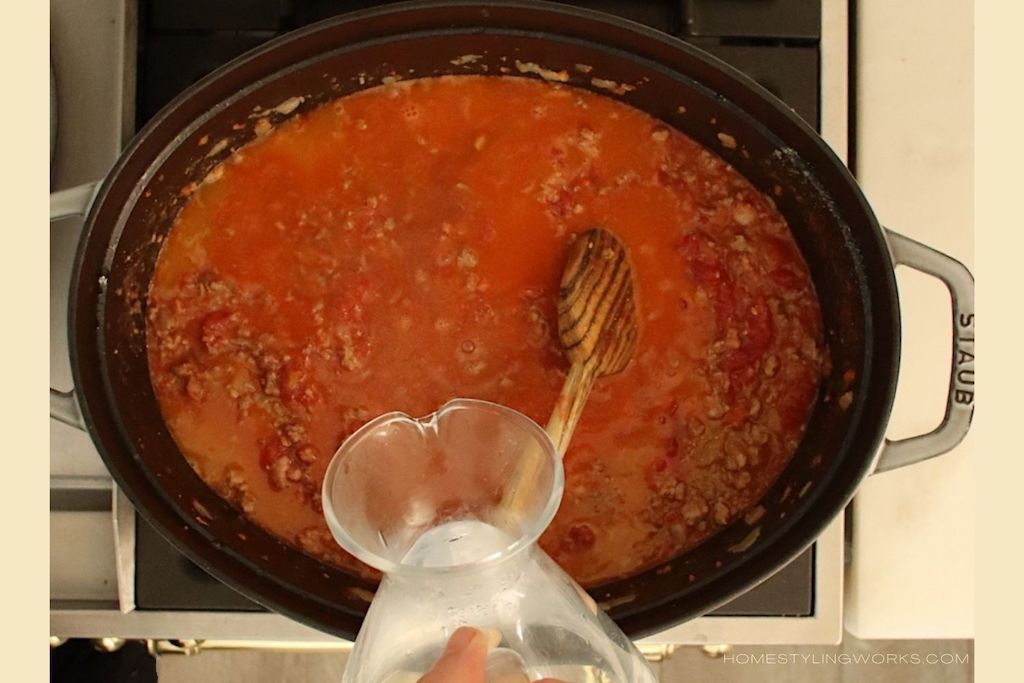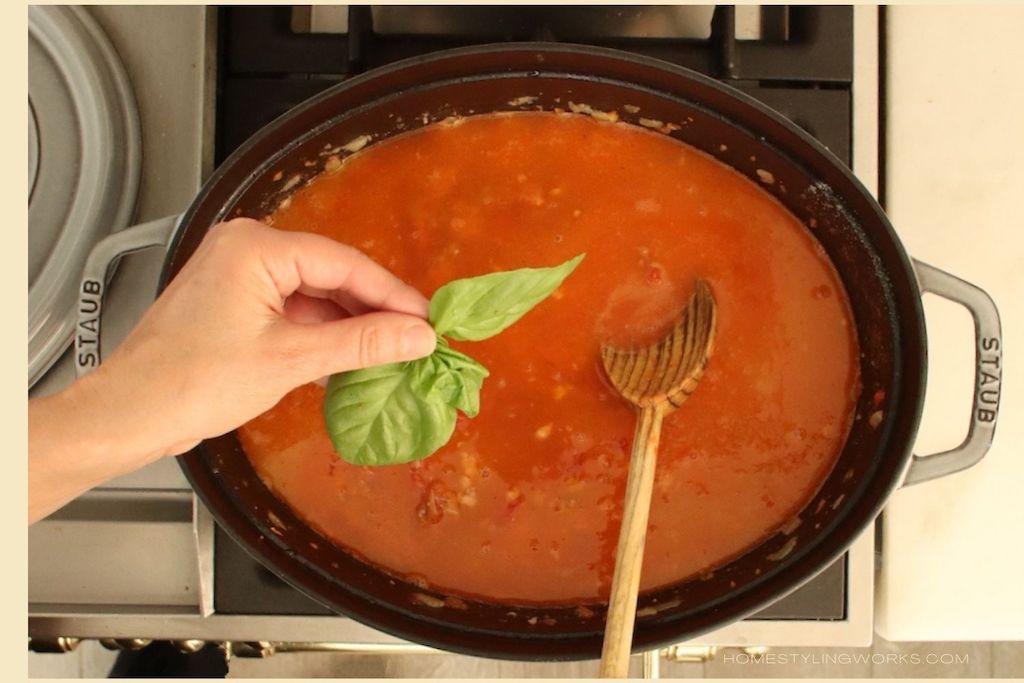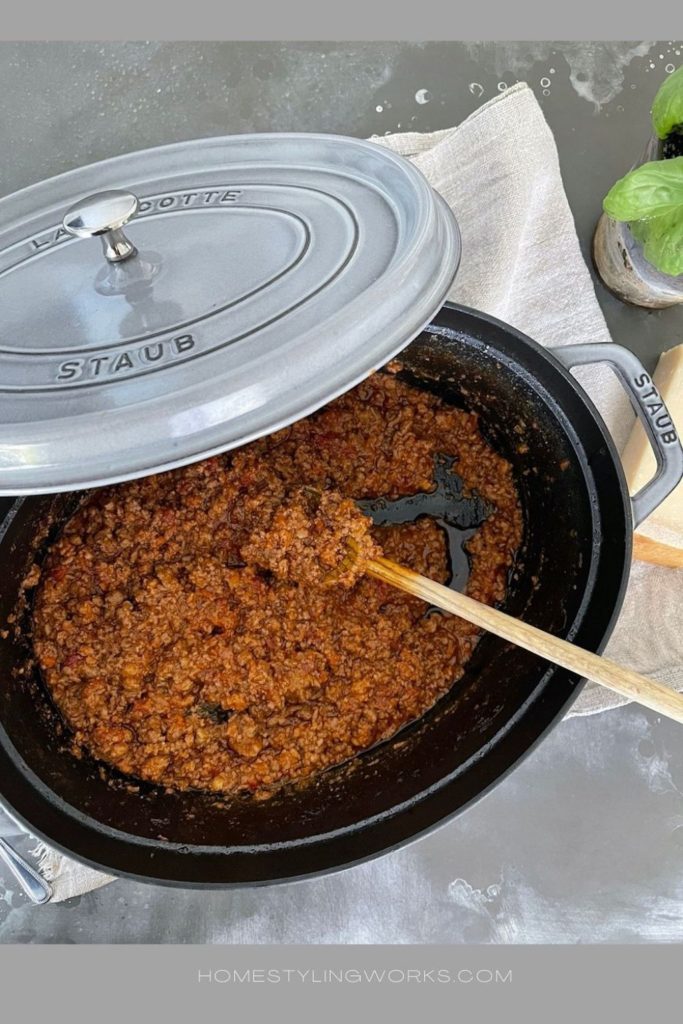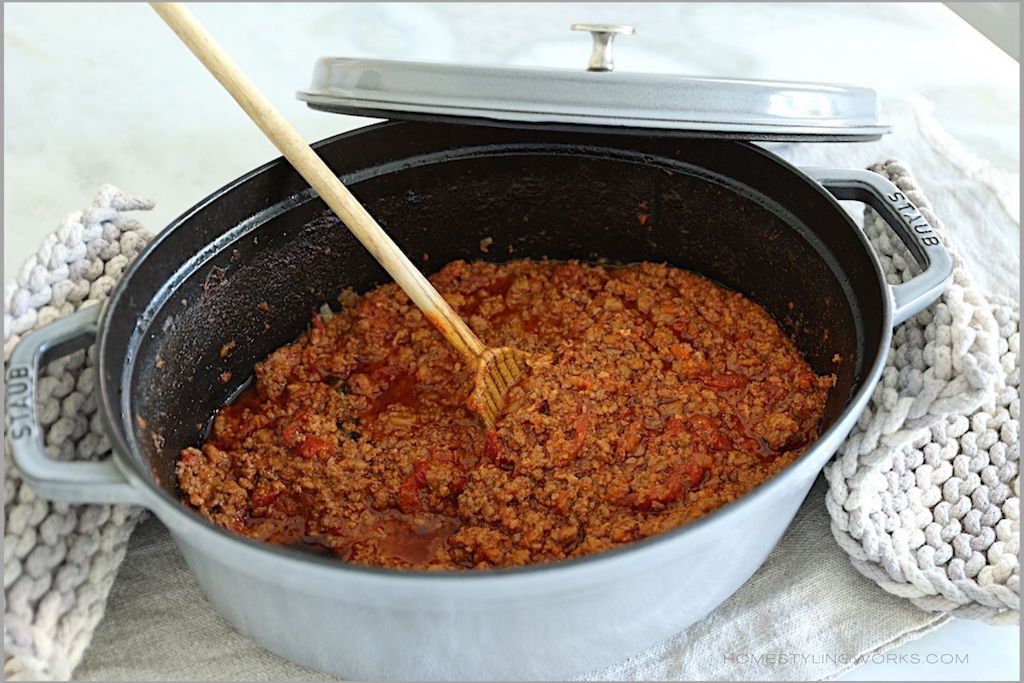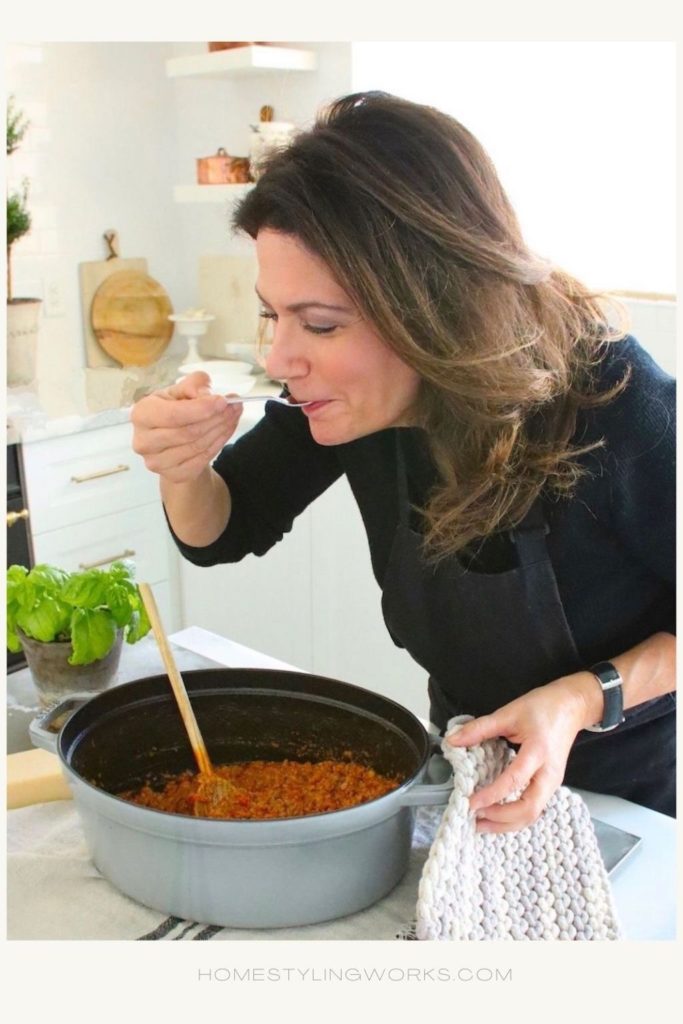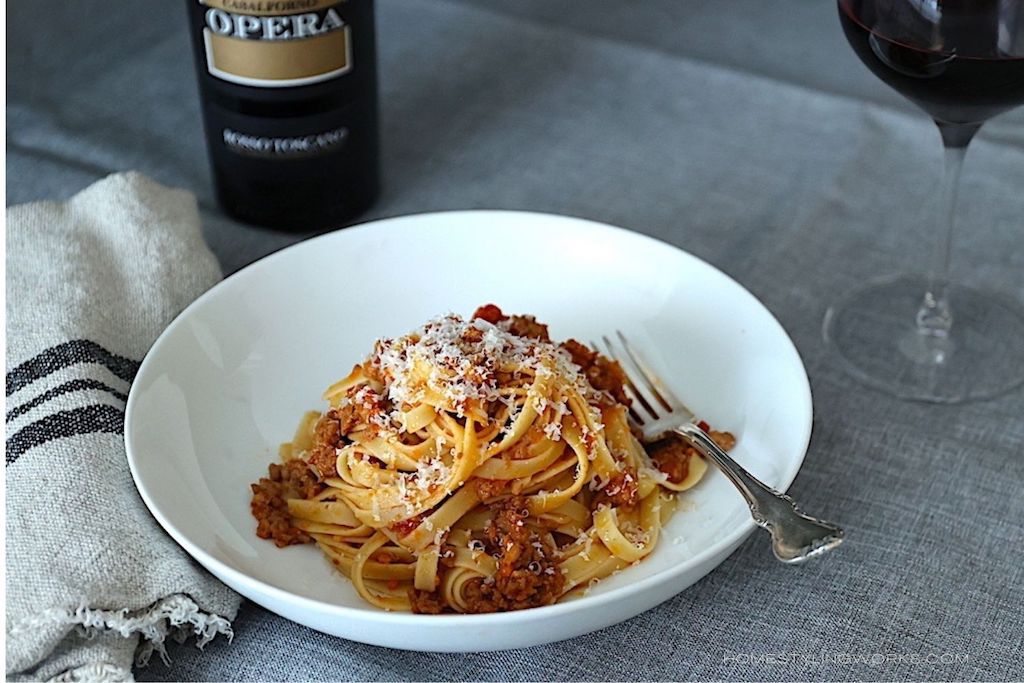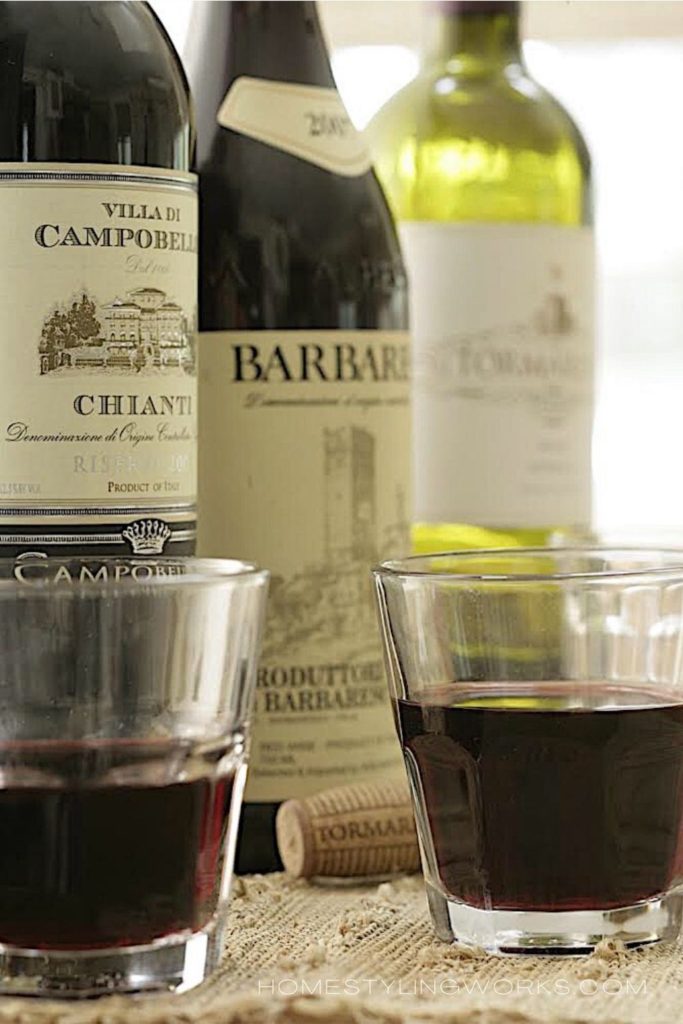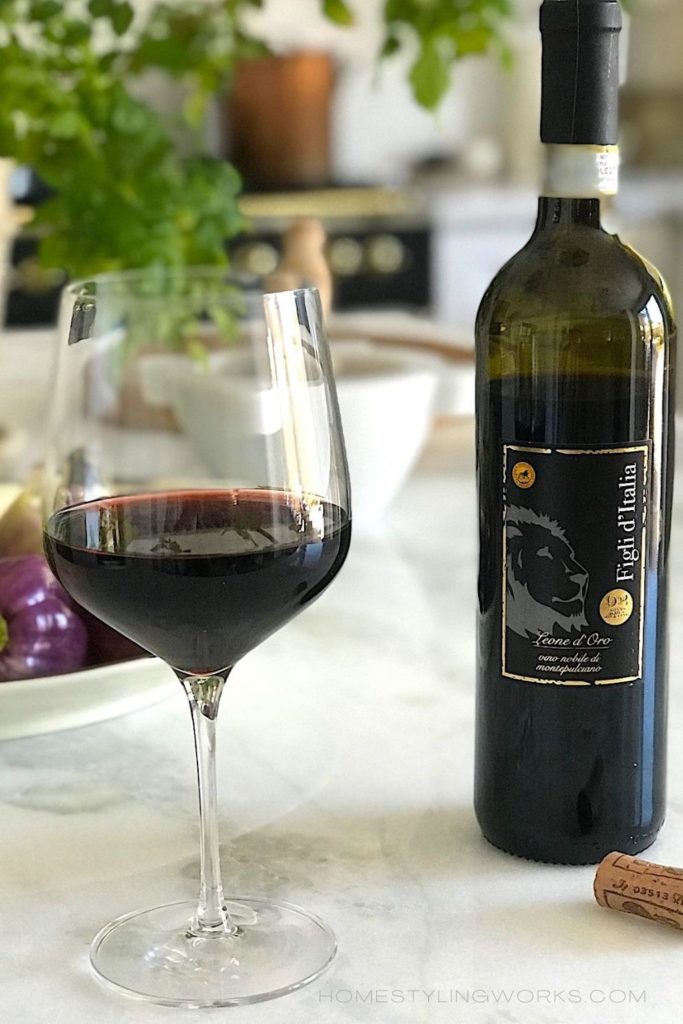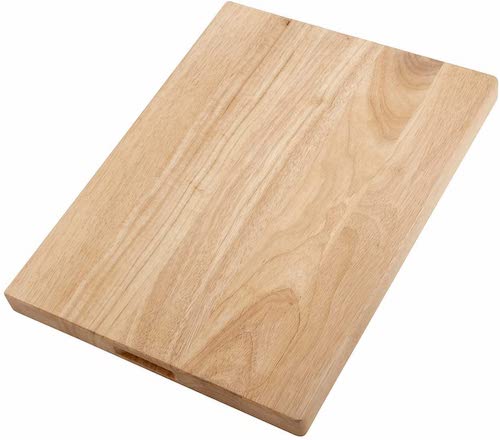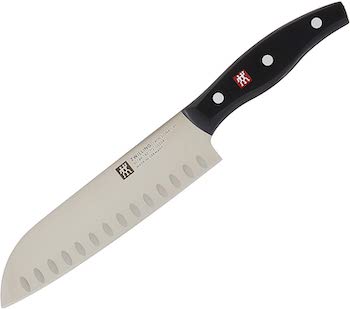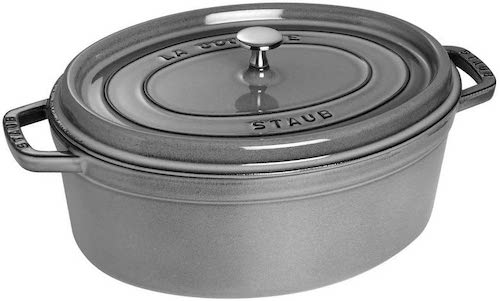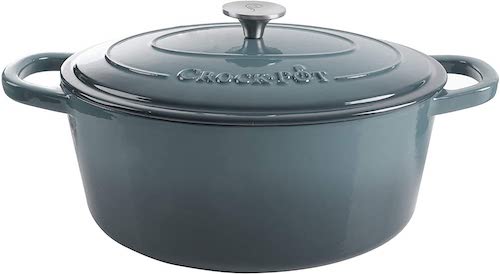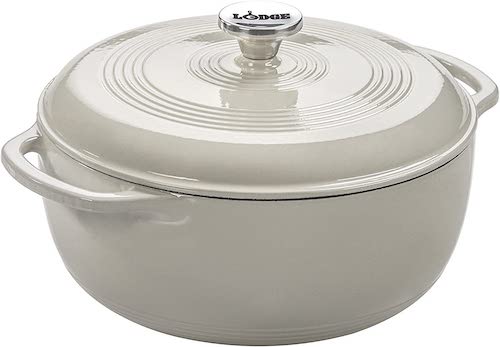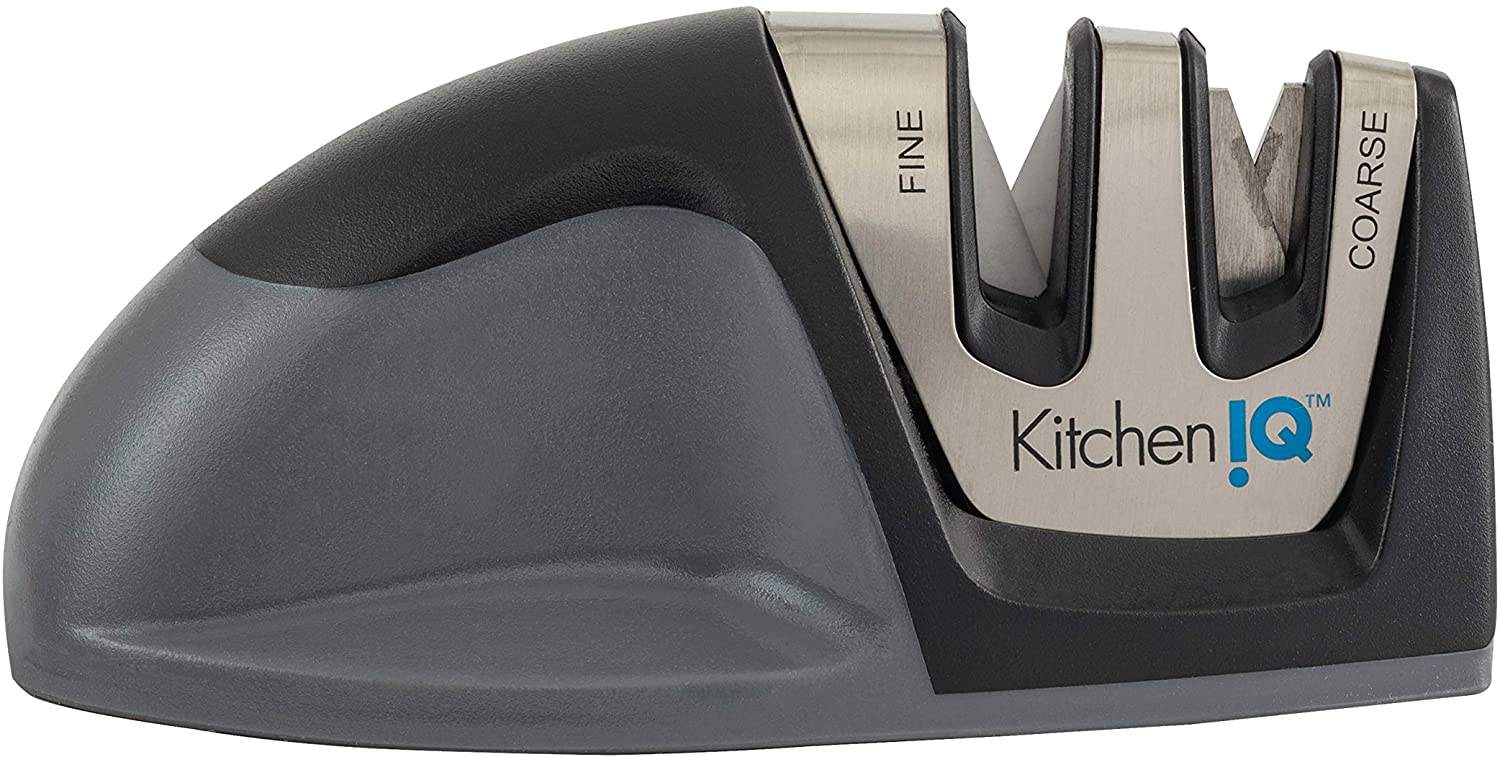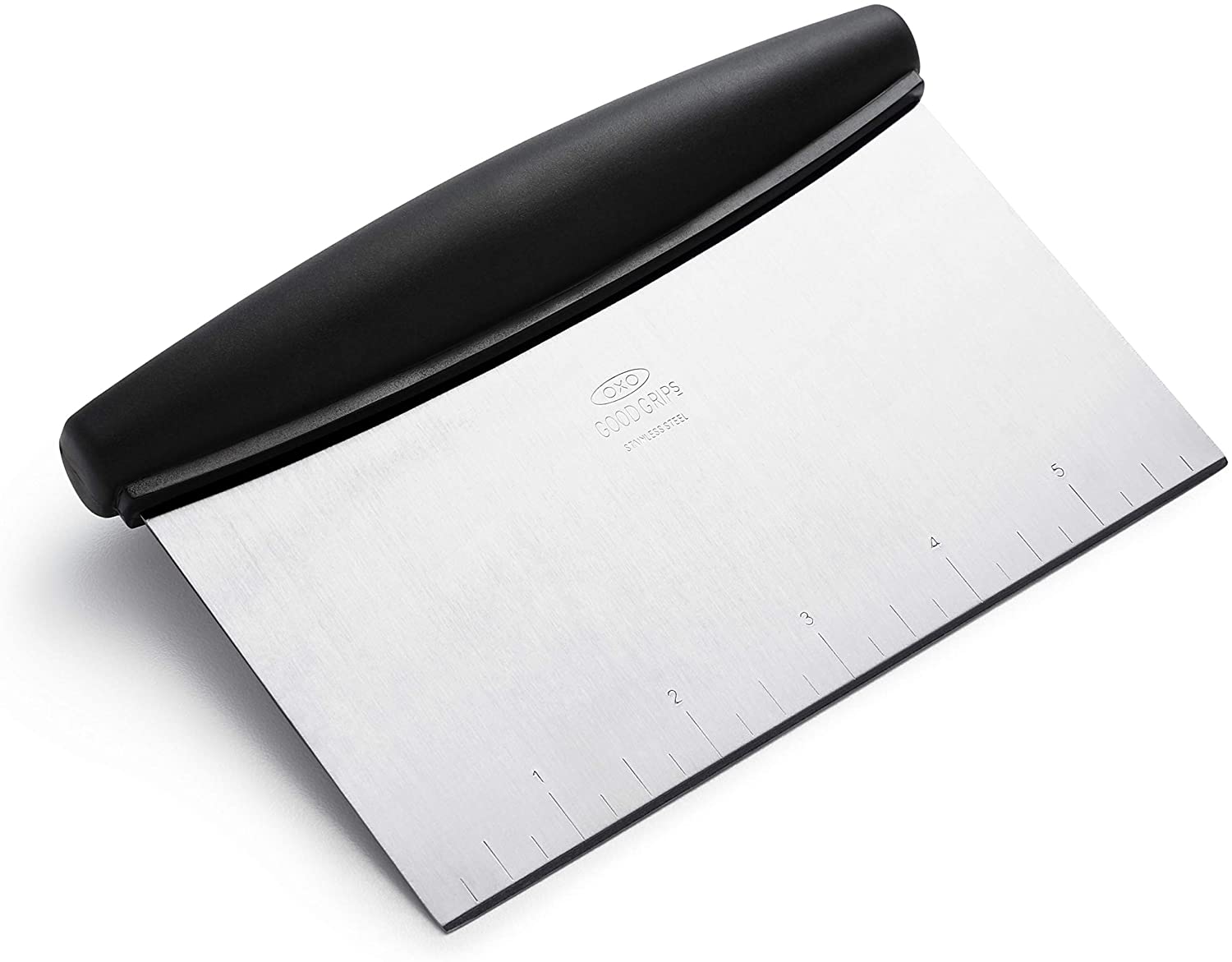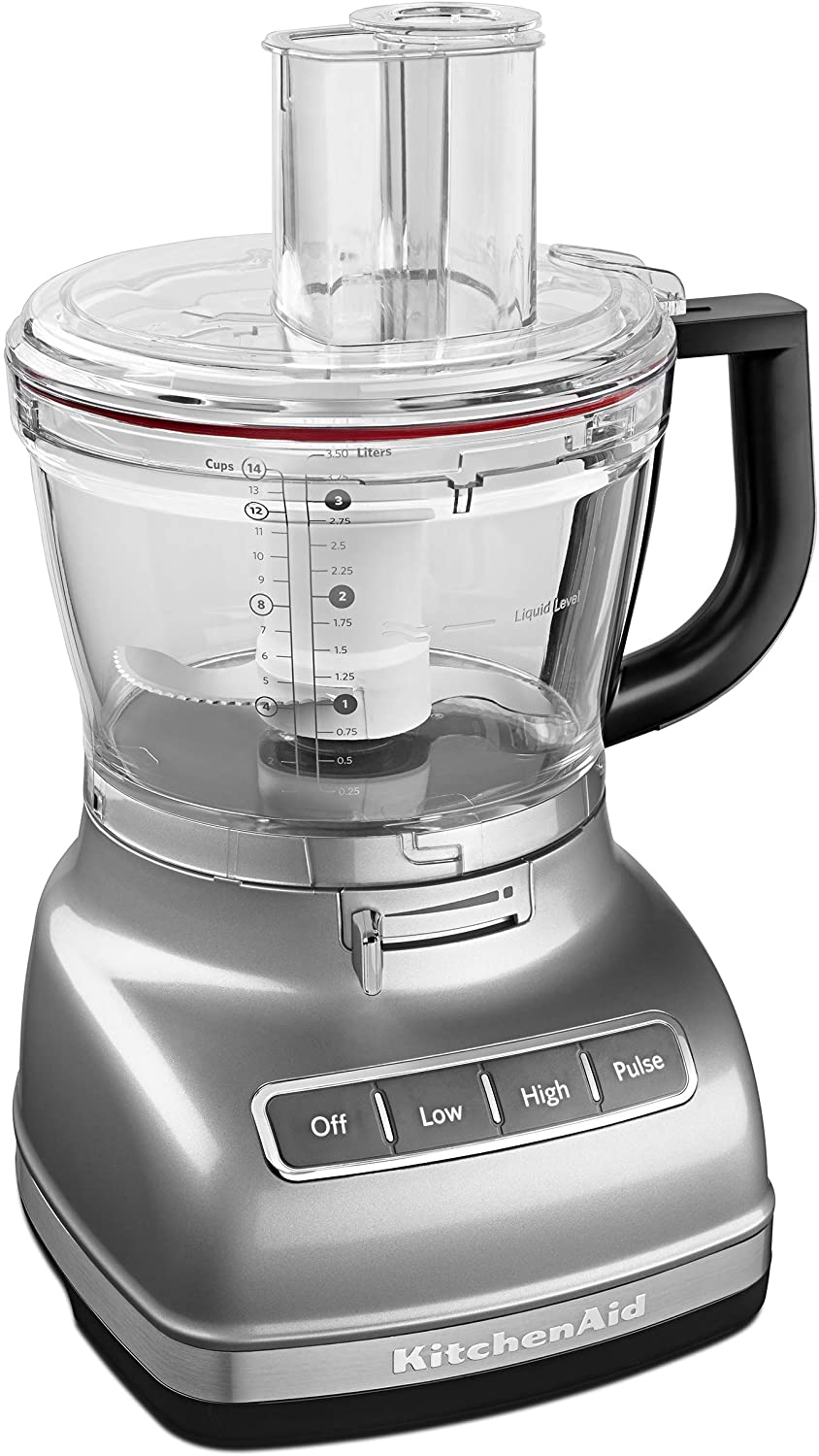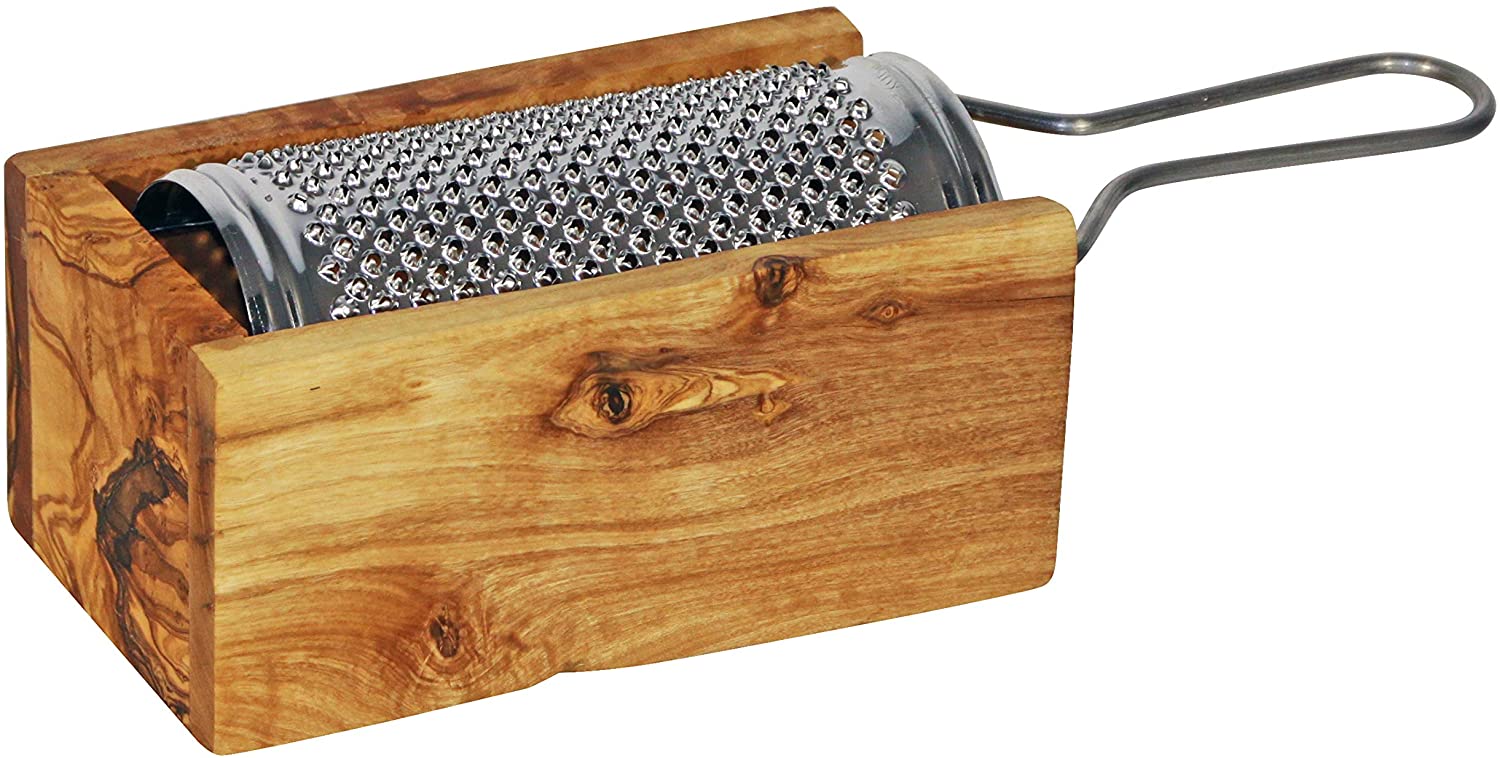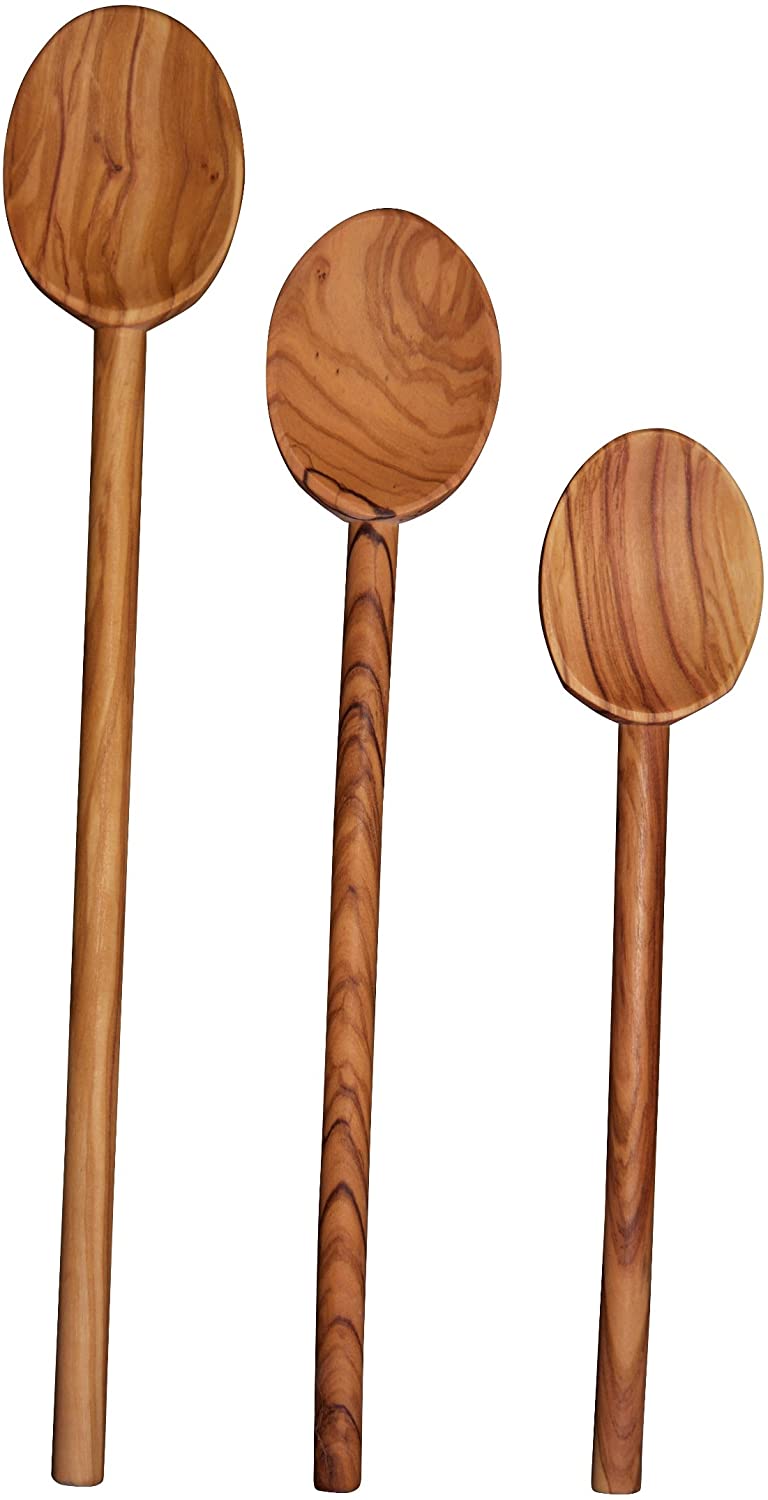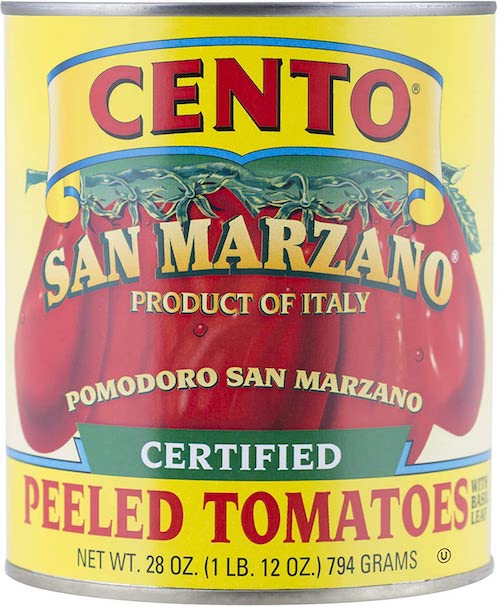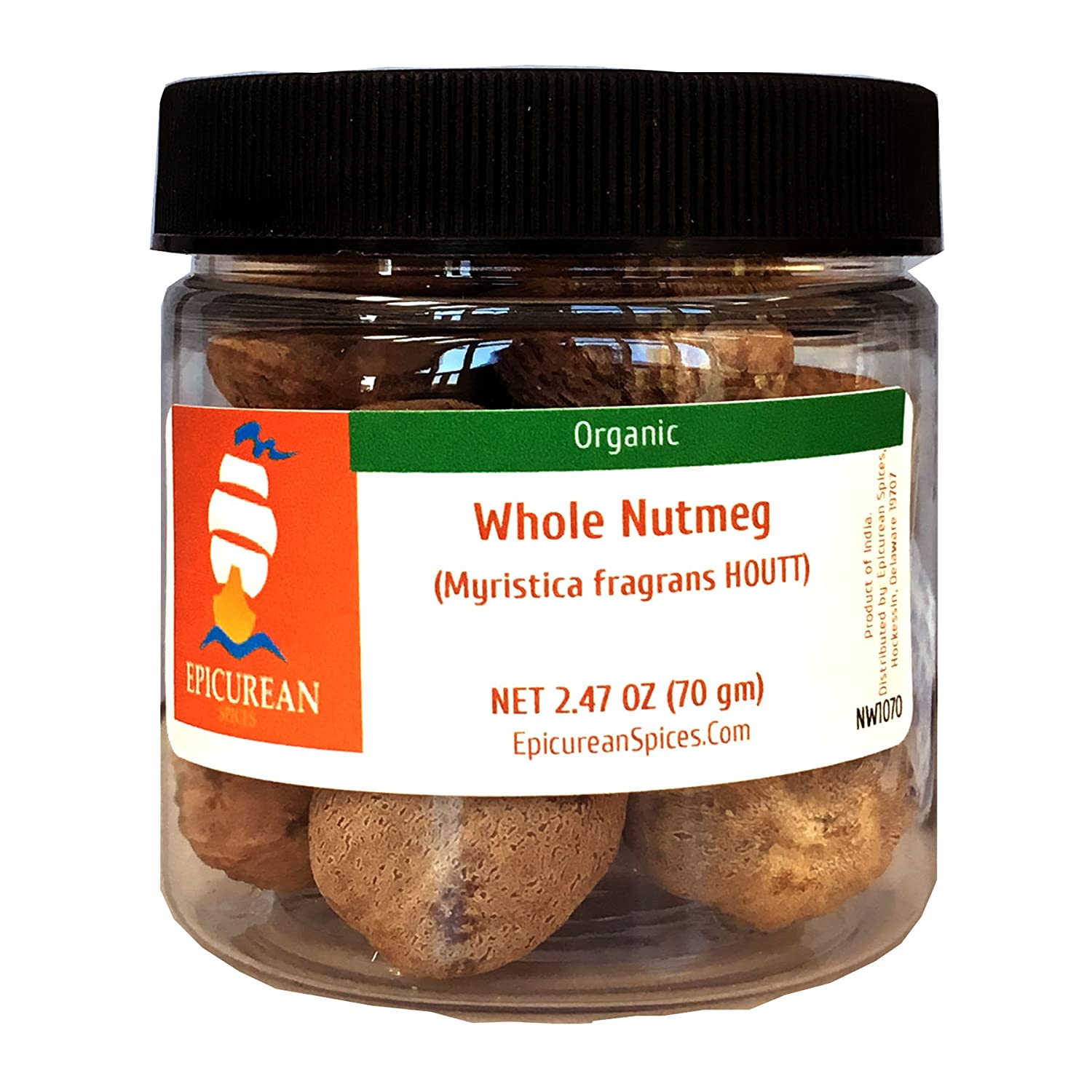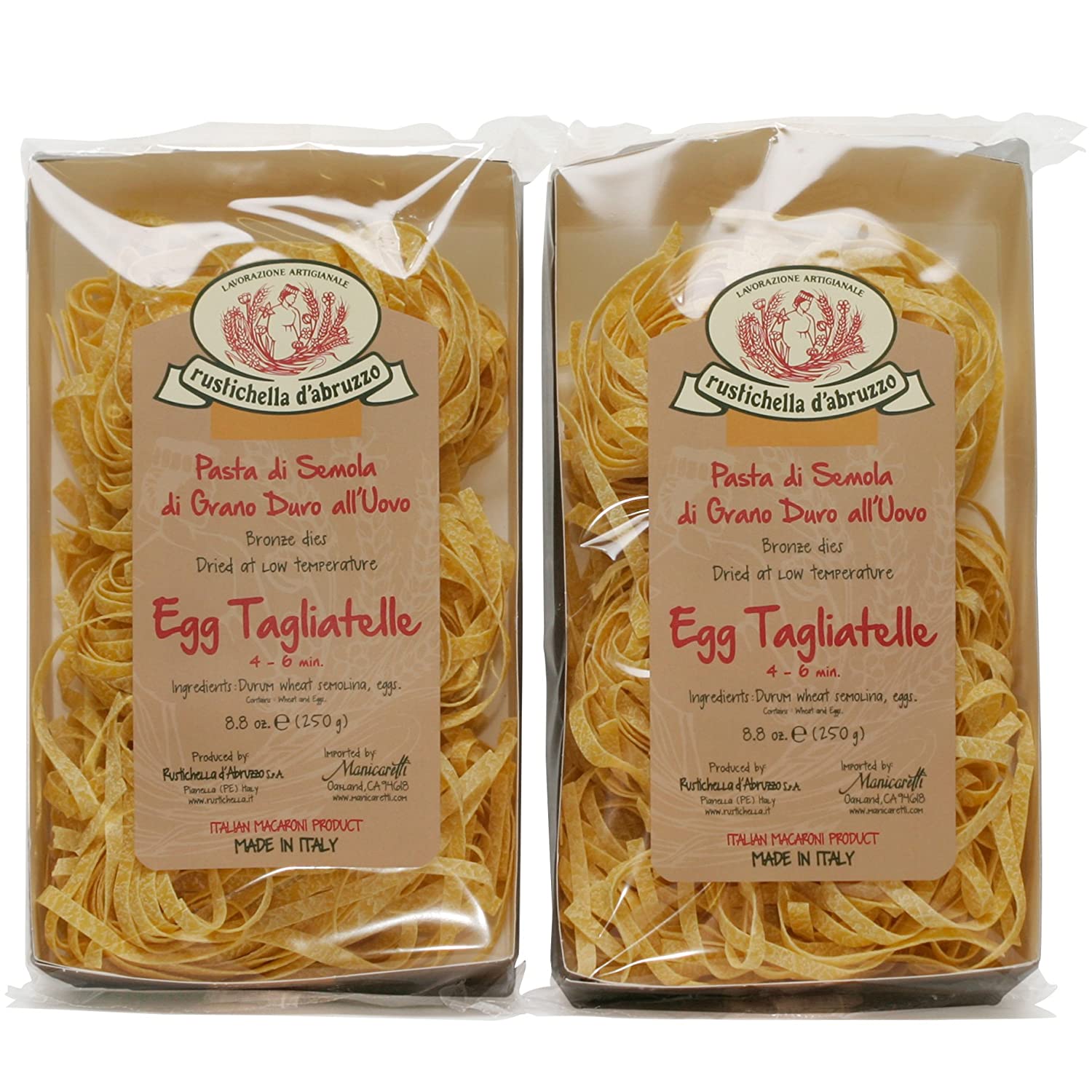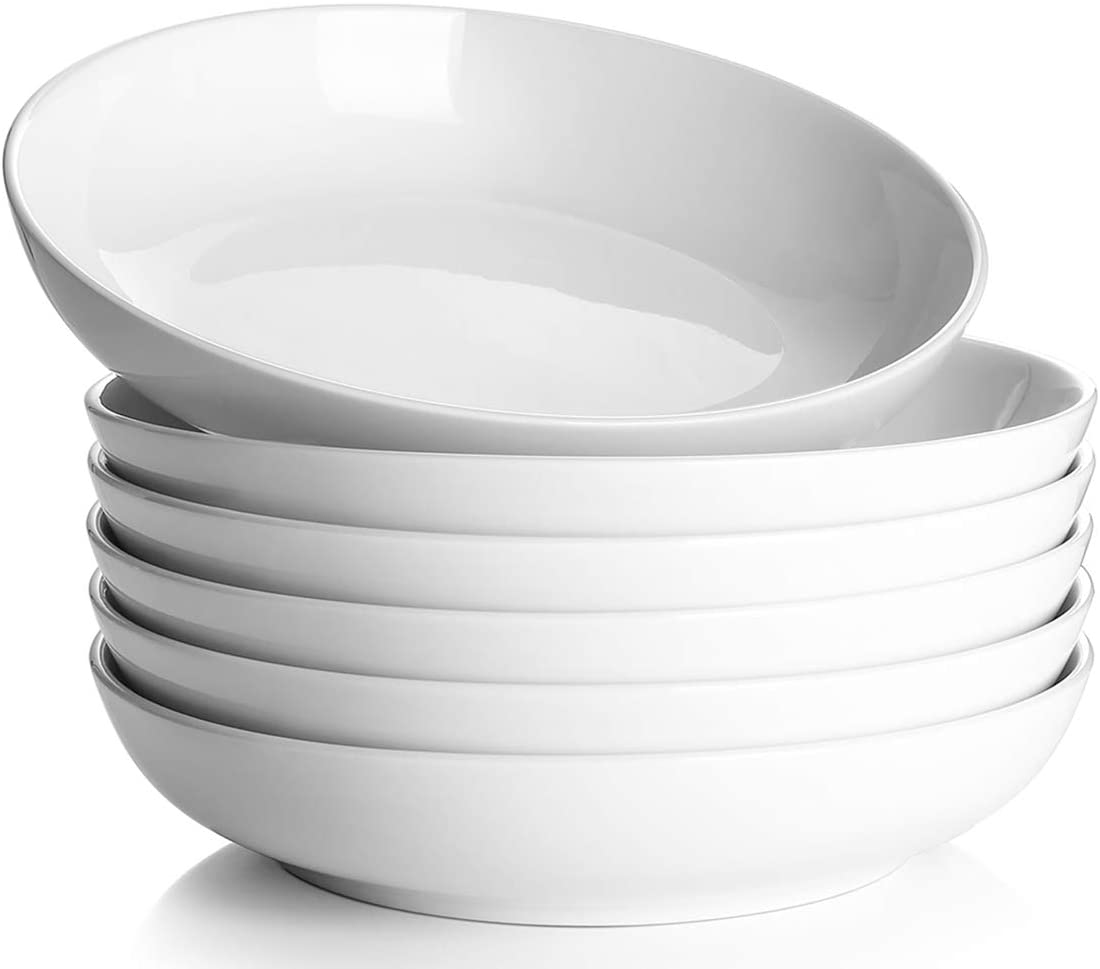THE BEST DISH I LEARNED HOW TO MAKE IN ITALY
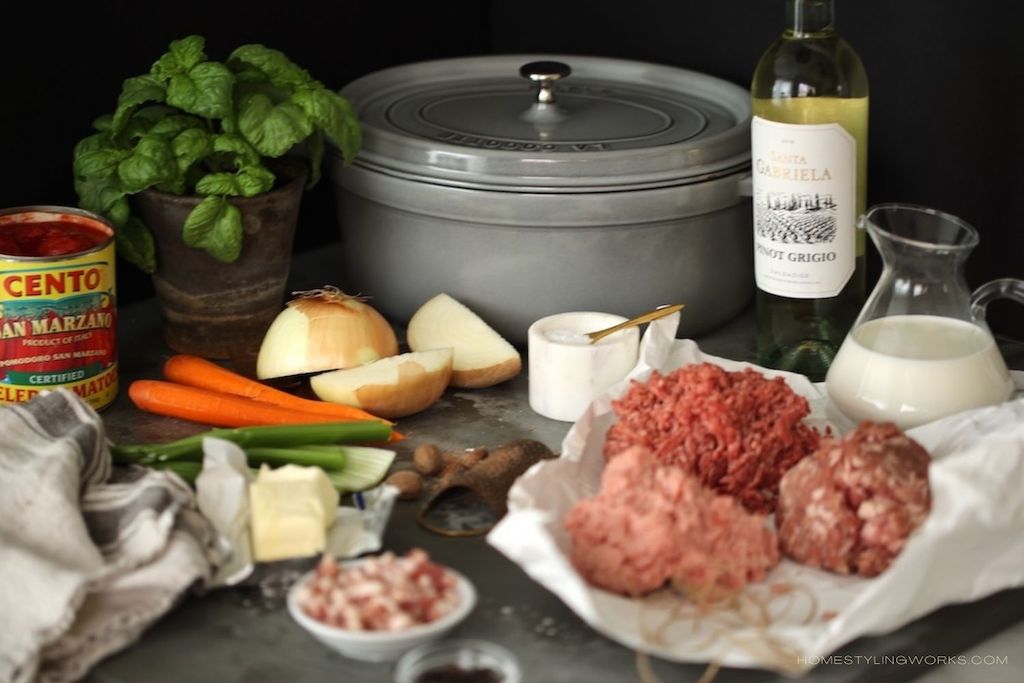
The Fine Art of Making a Classic Bolognese Sauce
-
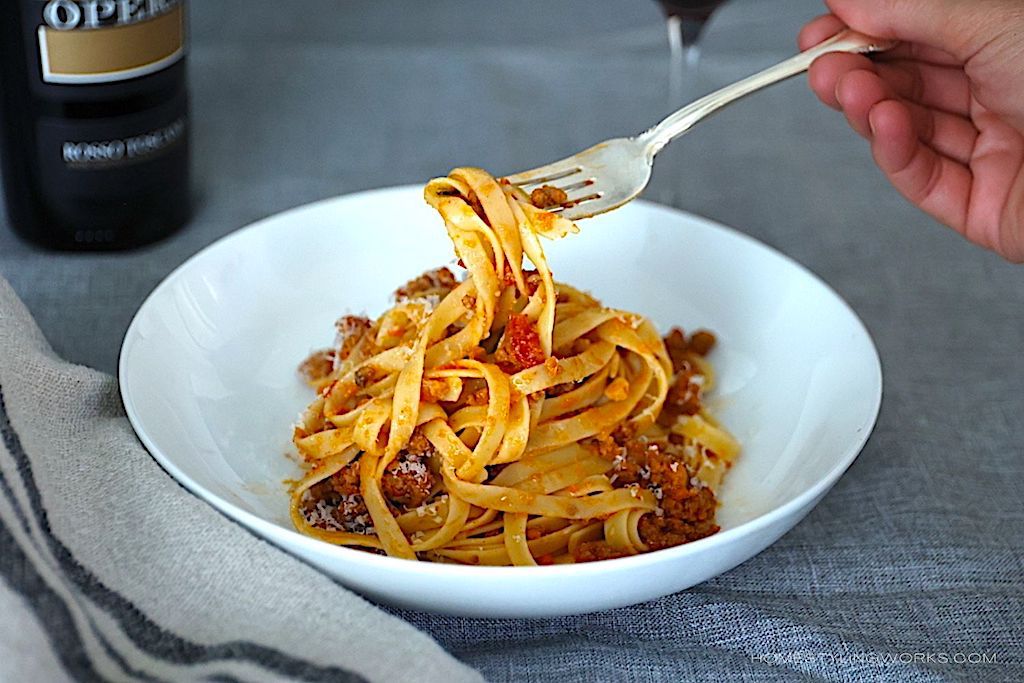
My signature dish, Tagliatelle Bolognese
You don’t have to be a chef to have a “signature dish”. Something you’re known for that friends and family request over and over. My signature dish happens to be Bolognese Meat Sauce. Like, from Bologna, Italy. True Italian Meat Sauce.
Not to be confused with the Italian-American “Sunday Gravy” of my Chicago childhood – red sauce, tomato-driven, with meatballs and sausage cooked all day in the gravy. It’s good, but it’s not Bolognese.
I first learned how to make Bolognese several years ago from my favorite cookbook author, the late Marcella Hazan, in her “Essentials of Italian Cooking” cookbook (see my post about Marcella and “Cookbooks That Will Make You A Restaurant-Good Home Cook“).
On my many trips to Italy over the years, I’ve been fortunate enough to visit the food capital of Italy, Bologna, a couple of times. When my husband and I visited a few years ago, I took a cooking class that involved making homemade pasta and – you guessed it – Bolognese. But what surprised me was that the recipe we made in class wasn’t at all like the Marcella version. Tomato paste vs. crushed San Marzano tomatoes. Red wine vs. white wine. Olive oil vs. butter. No pancetta vs. pancetta. That’s where I learned an important lesson about Regional Italian Cooking.
From that cooking class, I learned that nearly every family in the Northern Emilia-Romagna region (where Bologna is located) has their own rendition of this classic dish.
I thought to myself: “You mean I can make my own version of Bolognese and not be ostracized from the Italian Club??” With that tacit approval in the back of my mind, I returned home and decided to experiment a bit, using Marcella’s recipe as my starting point.
My recipe evolved over time, and I finally came up with the version that I’m sharing with you today. Not only has Bolognese become my signature dish, but it’s one of my husband’s favorite meals that I make (with a nice memory of our trip to Bologna to go alongside it). There’s always a container (or two or three) in our freezer – because this freezes beautifully, as well. Also, I usually double the recipe. Trust me, you’ll want leftovers.
Here’s the recipe below, followed by my step-by-step tutorial, with photos and instructions.
Bolognese Sauce
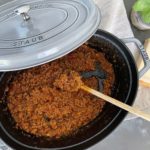
My rendition of this classic meat ragu that originated in Bologna, Italy
- Cast enamel dutch oven, food processor
- 1 Tbsp. vegetable oil
- 3 Tbsp. unsalted butter
- 1 large onion (finely chopped)
- 2 carrots (peeled and chopped into 1" pieces)
- 2 stalks celery (chopped into 1" pieces)
- 1/2 cup chopped pancetta
- 1 lb. ground chuck
- 1/2 lb. ground pork
- 1/2 lb. ground veal
- 1 cup whole milk
- 1/8 tsp. fresh nutmeg (grated)
- 1 cup dry white wine ((Pinot Grigio or Sauvignon Blanc))
- 1 28 oz. can whole San Marzano tomatoes with their juice (crushed by hand)
- 1 cup water
- Sprig of fresh basil
- Salt
- Freshly ground black pepper
- 1 1/2 lbs. pasta (tagliatelle or fettucine)
- Grated Parmigiano Reggiano
1. In a food processor, pulse the roughly chopped carrots, celery and pancetta for about 10 seconds. Set aside.
In a large Dutch oven, add vegetable oil and butter over medium heat.
When butter is melted, add finely chopped onions and cook until translucent.
Add pulsed carrot, celery and pancetta mixture to onions and stir to combine. Add a pinch of salt and pepper and sauce the soffritto (vegetable mixture) for about 10 minutes.
Next, add the ground chuck, pork and veal to the soffritto. Combine the meat with the vegetables, add a large pinch of salt and freshly ground pepper to the mixture.
Cook the meat (breaking it up with a wooden spoon) until the meat has lost its pink color (about 10-15 minutes).
Add the milk to the meat and let it simmer gently until the milk evaporates (10-15 minutes over medium heat).
Add the small grating of nutmeg.
When all the milk has evaporated, add the white wine and cook until all the wine evaporates (about 15 minutes).
Add the hand-crushed tomatoes to the pot, stir to combine, and turn the heat down to a low simmer.
Add 1 cup of water and a small sprig of basil. Stir to combine.
Partially cover the Dutch oven and let the sauce simmer for 4 hours (or longer). Periodically check on the sauce and give it a stir. If it looks too dry, add a little bit of water from time to time.
Serve over cooked tagliatelle, fettuccine or papardelle pasta, add a grating of fresh Parmigiano Reggiano and serve.
If you can’t find ground veal, the recipe can be made with 1 1/2 lbs. of ground chuck and 1/2 lb. of ground pork.
This recipe is easily doubled (using a larger Dutch oven), and freezes well for up to 3 months.
STEP-BY-STEP FROM MY KITCHEN
I’ll walk you through the ingredients – some of which may surprise you.
-
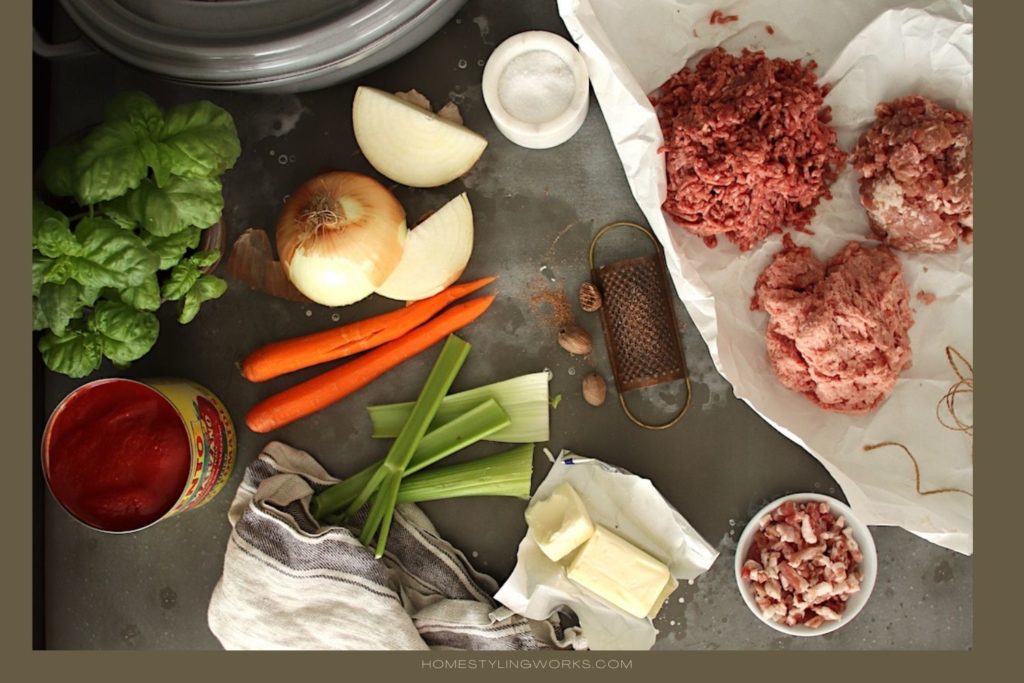
Everything you need to make Bolognese
THE KEY INGREDIENT
The most important ingredient in Bolognese isn’t an “ingredient”, per se. It’s TIME. As in tick-tock-tick-tock, at least four hours (or more). You don’t have to hover over it for four+ hours, but this isn’t something you’re going to whip up after you get home from work. This is not a 30-minute meal.
Now that we’ve got that out of the way, let’s get to the actual ingredients.
IT ALL STARTS WITH THE MEAT
The best way to describe Bolognese is meat-centric, with a tomato accent. It is definitely NOT a “red sauce” when it’s finished. As with most Italian foods, regional ingredients play a big part in their recipes. Northern Italy has more access to meat (versus Southern Italy, where there is more access to fish and vegetables).
The first area that I diverge from Marcella’s recipe is the meat itself. Her recipe calls for ground chuck and ground pork. My recipe includes three kinds of meat: 1 lb. of ground chuck, 1/2 lb. of ground pork and 1/2 lb. ground veal. I’ve also upped the quantity of meat a bit. The ground veal is my special ingredient, which adds a sublime depth of flavor and silkiness to the finished ragu. But if you can’t find ground veal, use a total of 2 lbs. of ground meat (1-1/2 lbs. chuck, 1/2 lb. pork). An important point about the chuck: Make sure to use a higher fat content (80/20), because – why? Fat is flavor.
SOFFRITTO, YOU’RE UP NEXT
Soffritto? What’s with the fancy word? Well, it’s an Italian recipe, so we’ll use the Italian terms. Soffritto is the holy trinity of vegetables in Italian cooking: diced onion, carrots & celery, and it’s the versatile base for many long cooking dishes (in France, this same trinity is called a mirepoix. Same thing, different country).
So get out your good knife and cutting board – I’m going to share a quick tip with you for how to not bawl your eyes out when you’re chopping onions. It’s this little $5.99 gadget: a portable knife sharpener (shown in the images below). I use this before I start chopping anything. No tears were shed in the photographing of this post, thanks to my little sharpening tool.
First, chop the onion in a small-to-medium dice and set aside (using the handy bench scraper – another favorite kitchen tool of mine).
Next is where I do something very different with my soffritto (and probably a little controversial for hard-core Italian cooks). Instead of practicing my dicing skills with the carrots and celery, I cut them into 1″ pieces
Now for the controversial part. I get out the food processor and pulse the carrots and celery for 10 seconds (along with 1/2 cup of diced pancetta – which is unsmoked Italian bacon) until it forms a rough paste.
The reason for this step is I found that in making Marcella’s recipe over the years (which involved dicing the carrots and celery), there would still be small pieces of carrots visible in my finished ragu (no matter how finely I chopped them). I wanted my ragu to be all about the meat, because this is a MEAT sauce.
NEXT UP: PLAYING WITH YOUR FOOD
Canned whole San Marzano tomatoes (the good stuff) are up next. Get out a bowl, dump the can of tomatoes with their juice in there and crush the tomatoes with your hands until they’re broken down. This is fun.
Now, go wash your hands and head to the stove.
MY FAVORITE POT IN THE KITCHEN
The pot that you choose to make your Bolognese is very important, since this is a long-cooking sauce. I highly recommend using a cast enamel Dutch oven. In fact, one of the best investments I’ve made in kitchen tools is my collection of different sizes of Dutch ovens by Staub and Le Creuset. There are also some nice Dutch ovens for under $100 that would work just fine for this recipe (here’s another option). I’ve found that the cast enamel Dutch ovens work the best for heat retention and non-stick factor – the 6 quart size is the most versatile. I’ve tried making Bolognese in a rental vacation kitchen with an aluminum pot and I had a burned Bolognese situation after 4 hours.
LET’S GET COOKING!
In the Dutch oven, add vegetable oil and butter over medium heat. Add finely chopped onions and cook until translucent (about 10 minutes).
Next, add the pulsed carrot, celery and pancetta mixture to the pot. Add 1/2 tsp. of salt and a few grinds of black pepper. Cook for another 5 minutes, until all the veg are incorporated and softened.
Add the meats to the soffritto mixture, along with a large pinch of salt and more freshly ground pepper (it’s important to season each layer of the sauce, for depth of flavor). Stir to combine the meat with the soffrito and cook the meat over medium heat, breaking it up with a wooden spoon, until the meat has lost its raw, pink color. You don’t want to brown the meat; this step is just to remove the rawness from the meat.
Add 1 cup of whole milk to the meat mixture and about 1/8 tsp. of freshly ground nutmeg (that’s one of Marcella’s signature ingredients in the Bolognese). Give the mixture a stir and let it simmer gently, about 10-15 minutes, until the milk evaporates. The milk is important to counter the richness of all the meats.
After all the milk has evaporated, add 1 cup of dry white wine (Pinot Grigio or Sauvignon Blanc would work fine), and cook until all the wine evaporates (about 15 minutes).
Next, add the hand-crushed tomatoes, 1 cup of water and a sprig of fresh basil to the pot.
Turn the heat down to a very low simmer, partially cover the pot and let it simmer away for 4 hours. Check it from time to time and give it a stir. If the sauce is looking a little dry, add water to the pot. The finished Bolognese will look like the shots below. Meat sauce with a tomato accent.
And don’t forget to taste for seasoning!
EAT YOUR PASTA, DRINK YOUR WINE
Bolognese is typically served with long noodles, such as tagliatelle or fettuccine. It is also a key ingredient in Lasagna alla Bolognese (I’ll share that recipe with you in a future post). This recipe is enough for 2 lbs. of pasta. Remember that in Italy, they don’t bathe the pasta in the sauce – the sauce caresses (and lightly coats) the pasta.
PASTA COOKING TIP
When you cook the pasta, reserve about 1/2 cup of the starchy water to help loosen the Bolognese when you mix the sauce with the pasta. Drain the pasta, add it back to the pan (reserving the water) and add the Bolognese to the cooked pasta noodles, one ladle at a time. Gently mix and add a little more Bolognese to lightly coat the pasta. After plating the pasta, pass the freshly grated Parmigiano Reggiano.
MORE ON THE “DRINK YOUR WINE” PART
A nice, fruity Sangiovese pairs well with Bolognese, and you can do a budget-friendly Chianti Classico or a more splurge-worthy Brunello di Montalcino (my personal favorite). Barolo and Barbaresco (made with the Nebbiolo grape) also make a lovely pairing with Bolognese. A Montepulciano is another reasonably priced Italian varietal that pairs well with this dish.
BOLOGNESE SHOPPING
Everything you need to make, serve (and freeze!) your Bolognese. Happy cooking – and buon appetito, everyone!

